A Case Study on Lassa Fever
VerifiedAdded on 2022/04/12
|39
|6112
|36
AI Summary
The Lassa virus infects humans by contact with food or household objects that have been exposed to rodent urine or faeces. Lassa fever is an acute viral hemorrhagic sickness with a duration of 2–21 days that only affects people in West Africa. Infections between people and laboratory transmission are also possible, especially in hospitals with insufficient infection prevention and control methods.
Contribute Materials
Your contribution can guide someone’s learning journey. Share your
documents today.
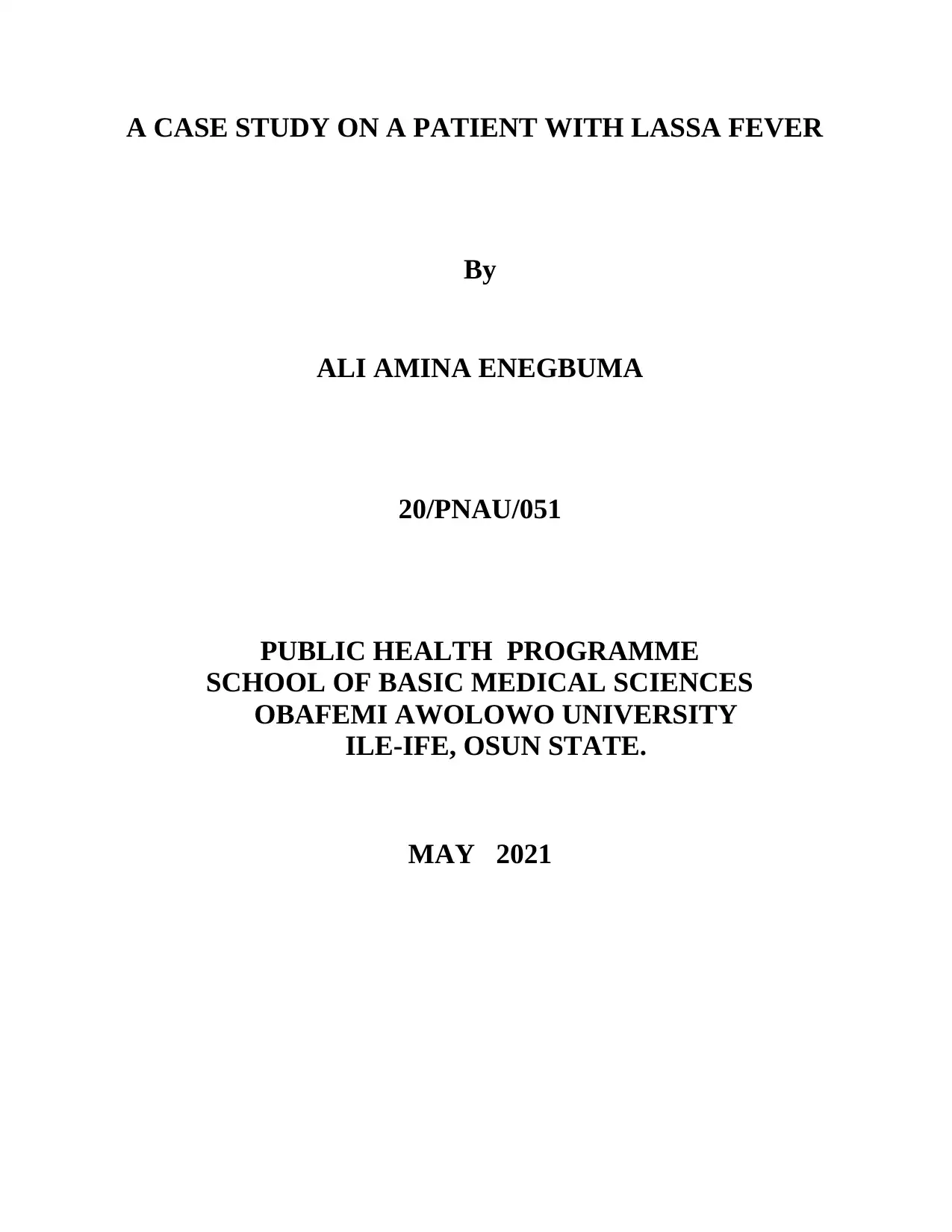
A CASE STUDY ON A PATIENT WITH LASSA FEVER
By
ALI AMINA ENEGBUMA
20/PNAU/051
PUBLIC HEALTH PROGRAMME
SCHOOL OF BASIC MEDICAL SCIENCES
OBAFEMI AWOLOWO UNIVERSITY
ILE-IFE, OSUN STATE.
MAY 2021
By
ALI AMINA ENEGBUMA
20/PNAU/051
PUBLIC HEALTH PROGRAMME
SCHOOL OF BASIC MEDICAL SCIENCES
OBAFEMI AWOLOWO UNIVERSITY
ILE-IFE, OSUN STATE.
MAY 2021
Secure Best Marks with AI Grader
Need help grading? Try our AI Grader for instant feedback on your assignments.
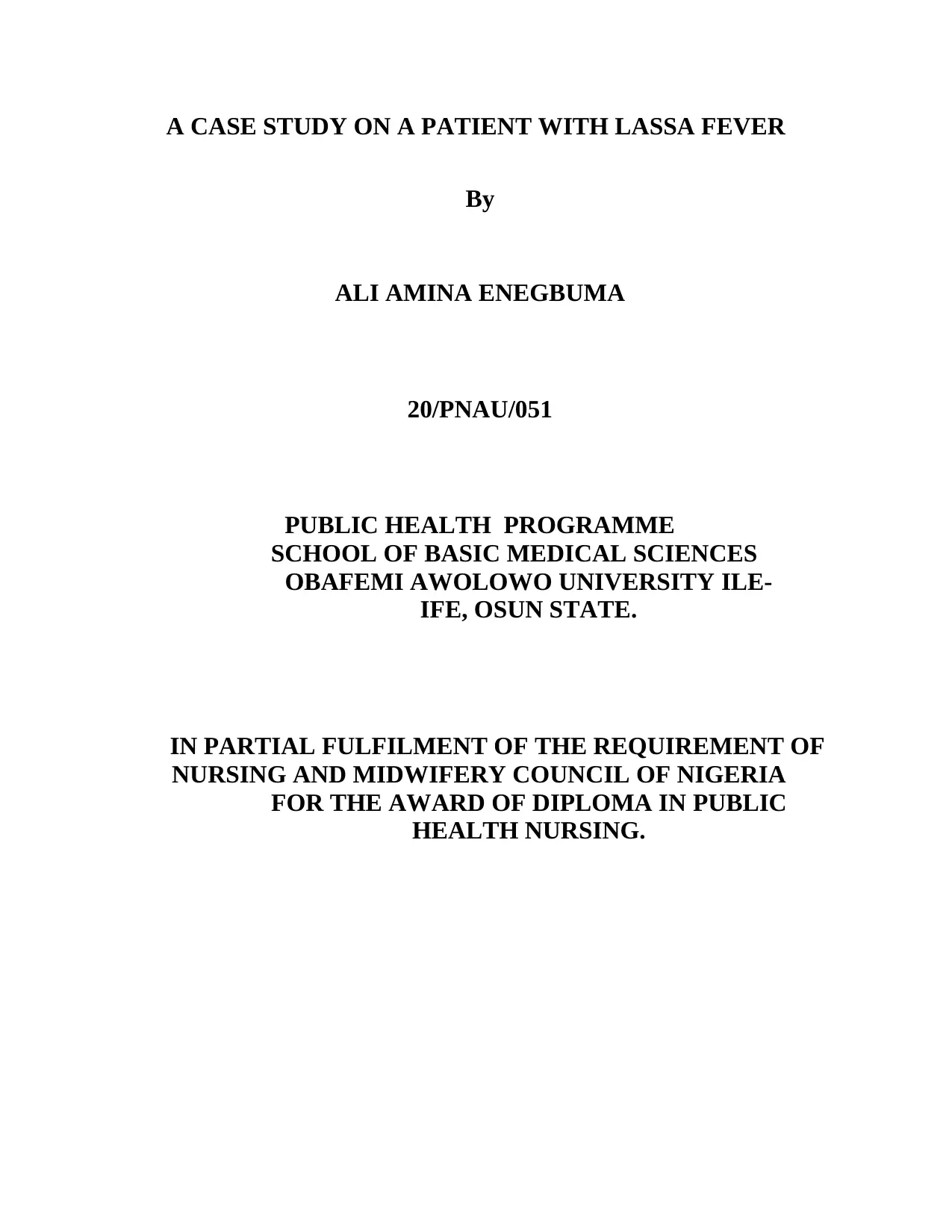
A CASE STUDY ON A PATIENT WITH LASSA FEVER
By
ALI AMINA ENEGBUMA
20/PNAU/051
PUBLIC HEALTH PROGRAMME
SCHOOL OF BASIC MEDICAL SCIENCES
OBAFEMI AWOLOWO UNIVERSITY ILE-
IFE, OSUN STATE.
IN PARTIAL FULFILMENT OF THE REQUIREMENT OF
NURSING AND MIDWIFERY COUNCIL OF NIGERIA
FOR THE AWARD OF DIPLOMA IN PUBLIC
HEALTH NURSING.
By
ALI AMINA ENEGBUMA
20/PNAU/051
PUBLIC HEALTH PROGRAMME
SCHOOL OF BASIC MEDICAL SCIENCES
OBAFEMI AWOLOWO UNIVERSITY ILE-
IFE, OSUN STATE.
IN PARTIAL FULFILMENT OF THE REQUIREMENT OF
NURSING AND MIDWIFERY COUNCIL OF NIGERIA
FOR THE AWARD OF DIPLOMA IN PUBLIC
HEALTH NURSING.
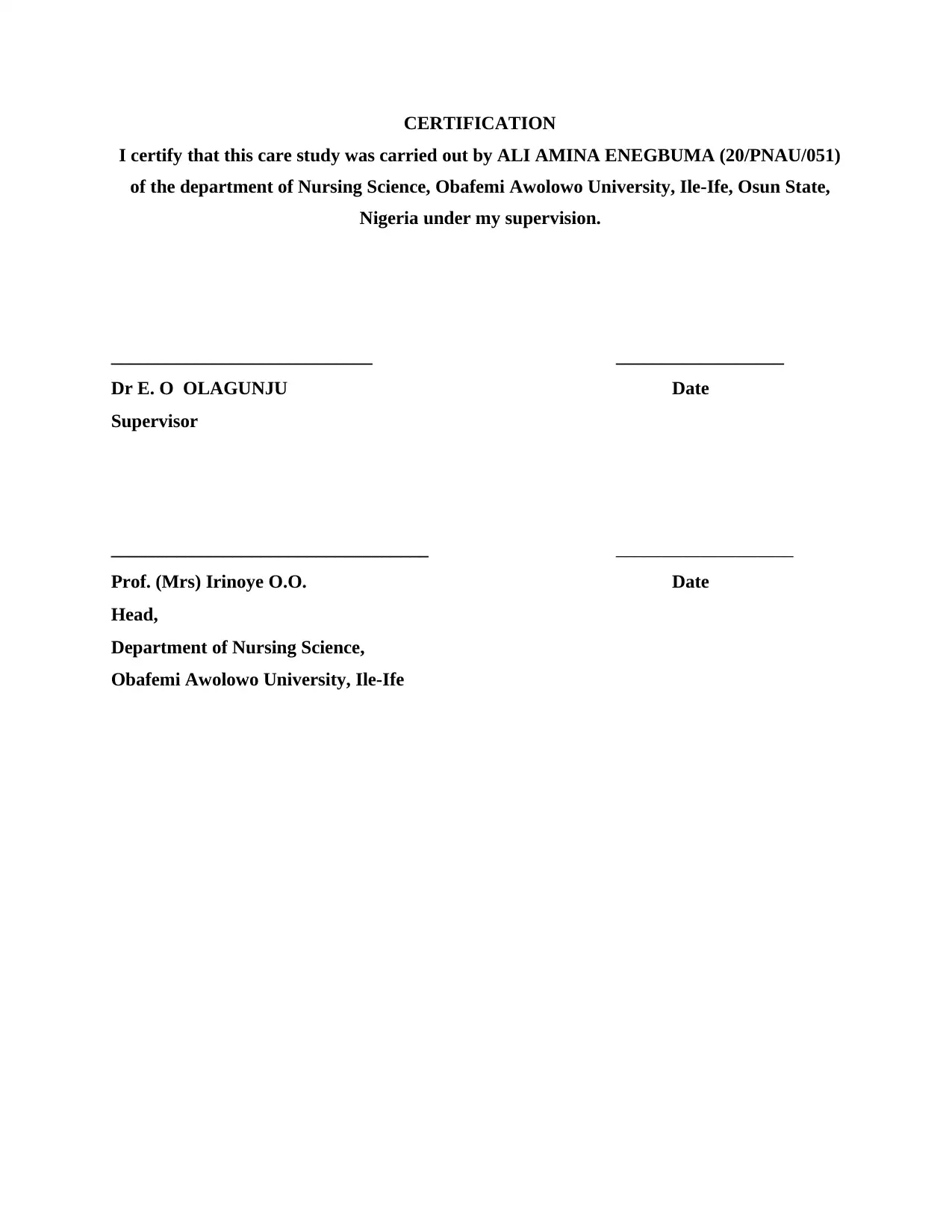
CERTIFICATION
I certify that this care study was carried out by ALI AMINA ENEGBUMA (20/PNAU/051)
of the department of Nursing Science, Obafemi Awolowo University, Ile-Ife, Osun State,
Nigeria under my supervision.
____________________________ __________________
Dr E. O OLAGUNJU Date
Supervisor
__________________________________ ___________________
Prof. (Mrs) Irinoye O.O. Date
Head,
Department of Nursing Science,
Obafemi Awolowo University, Ile-Ife
I certify that this care study was carried out by ALI AMINA ENEGBUMA (20/PNAU/051)
of the department of Nursing Science, Obafemi Awolowo University, Ile-Ife, Osun State,
Nigeria under my supervision.
____________________________ __________________
Dr E. O OLAGUNJU Date
Supervisor
__________________________________ ___________________
Prof. (Mrs) Irinoye O.O. Date
Head,
Department of Nursing Science,
Obafemi Awolowo University, Ile-Ife

DEDICATION
This research study is dedicated to Almighty God, the author and finisher of my faith and to my
lovely husband Mr. Cosmas Asimegbe, my beloved children Donald and Diane Asimegbe
ACKNOWLEDGMENT
My sincere gratitude to God Almighty, whose presence has never been far from me through my
B.Sc. programme and by whose grace this project has become possible.
I am grateful to my project supervisor, Dr (Mrs) O.E Olagunju under whose meticulous and
detailed supervision this research was conducted. I would also like to acknowledge my Head of
Department, Professor Omolola Irinoye and other lecturers who have imparted greatly both in this
project and to my life.
My deepest gratitude goes to my husband, Mr Asimegbe, you are a wonderful man. Thank you
for the support. My gratitude also goes to my siblings – Sophie and Udomo for support and
encouragement in making this programme a success. And to my lovely kids – Donald and Diane,
who filled my world with joy and challenged me to be the best.
To everyone who contributed to this success, my colleagues at work,friends and those who has
supported me in every way, i want to say a huge thank you.
This research study is dedicated to Almighty God, the author and finisher of my faith and to my
lovely husband Mr. Cosmas Asimegbe, my beloved children Donald and Diane Asimegbe
ACKNOWLEDGMENT
My sincere gratitude to God Almighty, whose presence has never been far from me through my
B.Sc. programme and by whose grace this project has become possible.
I am grateful to my project supervisor, Dr (Mrs) O.E Olagunju under whose meticulous and
detailed supervision this research was conducted. I would also like to acknowledge my Head of
Department, Professor Omolola Irinoye and other lecturers who have imparted greatly both in this
project and to my life.
My deepest gratitude goes to my husband, Mr Asimegbe, you are a wonderful man. Thank you
for the support. My gratitude also goes to my siblings – Sophie and Udomo for support and
encouragement in making this programme a success. And to my lovely kids – Donald and Diane,
who filled my world with joy and challenged me to be the best.
To everyone who contributed to this success, my colleagues at work,friends and those who has
supported me in every way, i want to say a huge thank you.
Secure Best Marks with AI Grader
Need help grading? Try our AI Grader for instant feedback on your assignments.
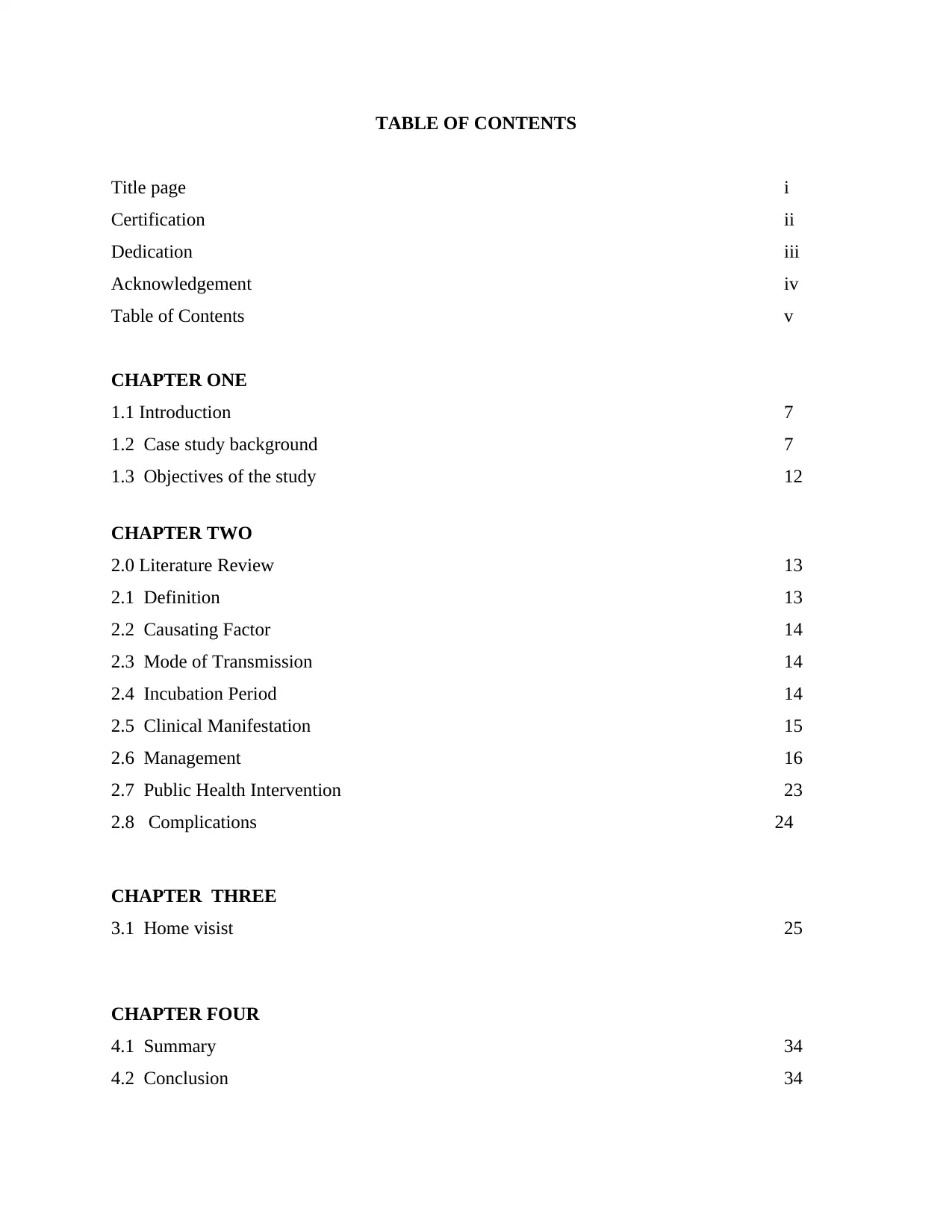
TABLE OF CONTENTS
Title page i
Certification ii
Dedication iii
Acknowledgement iv
Table of Contents v
CHAPTER ONE
1.1 Introduction 7
1.2 Case study background 7
1.3 Objectives of the study 12
CHAPTER TWO
2.0 Literature Review 13
2.1 Definition 13
2.2 Causating Factor 14
2.3 Mode of Transmission 14
2.4 Incubation Period 14
2.5 Clinical Manifestation 15
2.6 Management 16
2.7 Public Health Intervention 23
2.8 Complications 24
CHAPTER THREE
3.1 Home visist 25
CHAPTER FOUR
4.1 Summary 34
4.2 Conclusion 34
Title page i
Certification ii
Dedication iii
Acknowledgement iv
Table of Contents v
CHAPTER ONE
1.1 Introduction 7
1.2 Case study background 7
1.3 Objectives of the study 12
CHAPTER TWO
2.0 Literature Review 13
2.1 Definition 13
2.2 Causating Factor 14
2.3 Mode of Transmission 14
2.4 Incubation Period 14
2.5 Clinical Manifestation 15
2.6 Management 16
2.7 Public Health Intervention 23
2.8 Complications 24
CHAPTER THREE
3.1 Home visist 25
CHAPTER FOUR
4.1 Summary 34
4.2 Conclusion 34
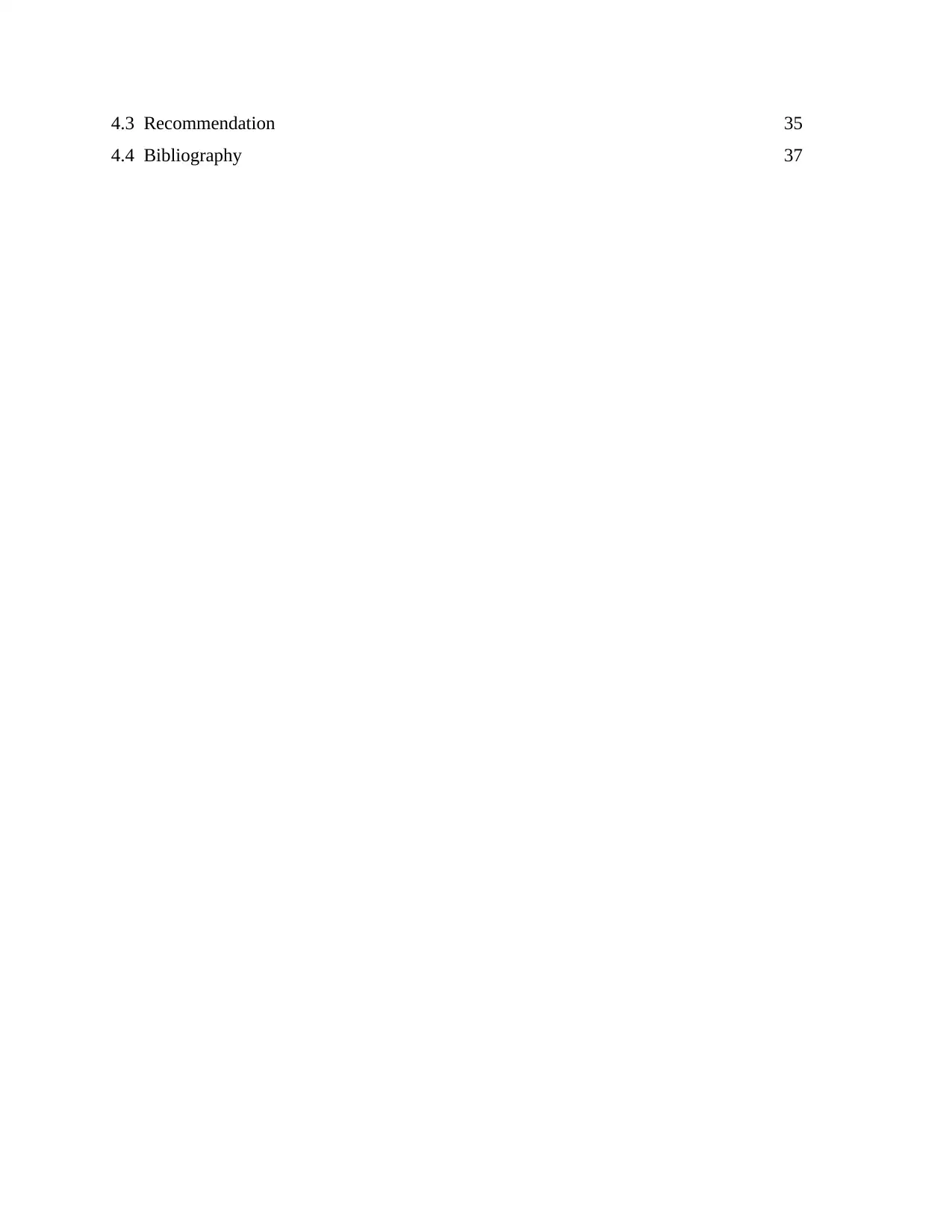
4.3 Recommendation 35
4.4 Bibliography 37
4.4 Bibliography 37
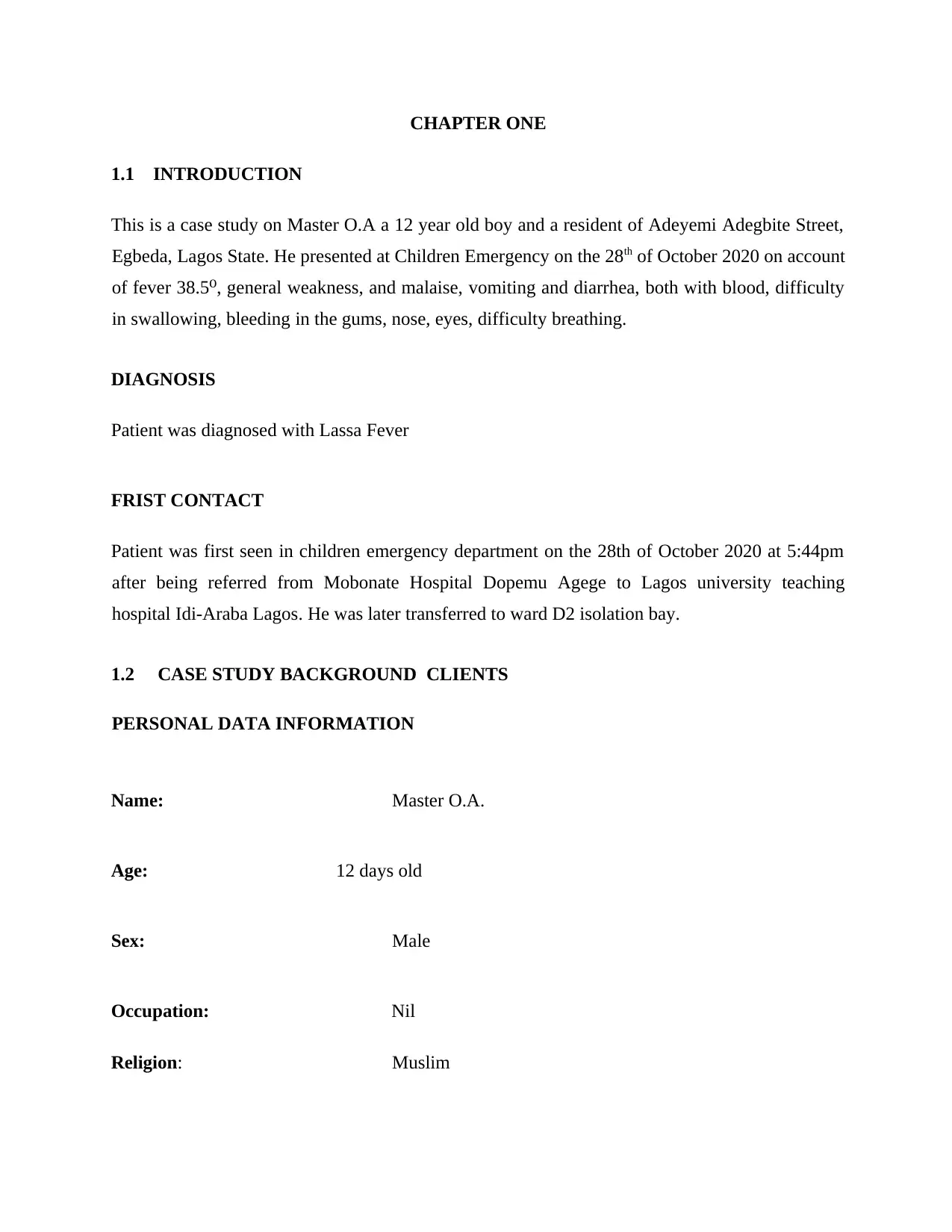
CHAPTER ONE
1.1 INTRODUCTION
This is a case study on Master O.A a 12 year old boy and a resident of Adeyemi Adegbite Street,
Egbeda, Lagos State. He presented at Children Emergency on the 28th of October 2020 on account
of fever 38.5 , general weakness, and malaise, vomiting and diarrhea, both with blood, difficulty⁰
in swallowing, bleeding in the gums, nose, eyes, difficulty breathing.
DIAGNOSIS
Patient was diagnosed with Lassa Fever
FRIST CONTACT
Patient was first seen in children emergency department on the 28th of October 2020 at 5:44pm
after being referred from Mobonate Hospital Dopemu Agege to Lagos university teaching
hospital Idi-Araba Lagos. He was later transferred to ward D2 isolation bay.
1.2 CASE STUDY BACKGROUND CLIENTS
PERSONAL DATA INFORMATION
Name: Master O.A.
Age: 12 days old
Sex: Male
Occupation: Nil
Religion: Muslim
1.1 INTRODUCTION
This is a case study on Master O.A a 12 year old boy and a resident of Adeyemi Adegbite Street,
Egbeda, Lagos State. He presented at Children Emergency on the 28th of October 2020 on account
of fever 38.5 , general weakness, and malaise, vomiting and diarrhea, both with blood, difficulty⁰
in swallowing, bleeding in the gums, nose, eyes, difficulty breathing.
DIAGNOSIS
Patient was diagnosed with Lassa Fever
FRIST CONTACT
Patient was first seen in children emergency department on the 28th of October 2020 at 5:44pm
after being referred from Mobonate Hospital Dopemu Agege to Lagos university teaching
hospital Idi-Araba Lagos. He was later transferred to ward D2 isolation bay.
1.2 CASE STUDY BACKGROUND CLIENTS
PERSONAL DATA INFORMATION
Name: Master O.A.
Age: 12 days old
Sex: Male
Occupation: Nil
Religion: Muslim
Paraphrase This Document
Need a fresh take? Get an instant paraphrase of this document with our AI Paraphraser
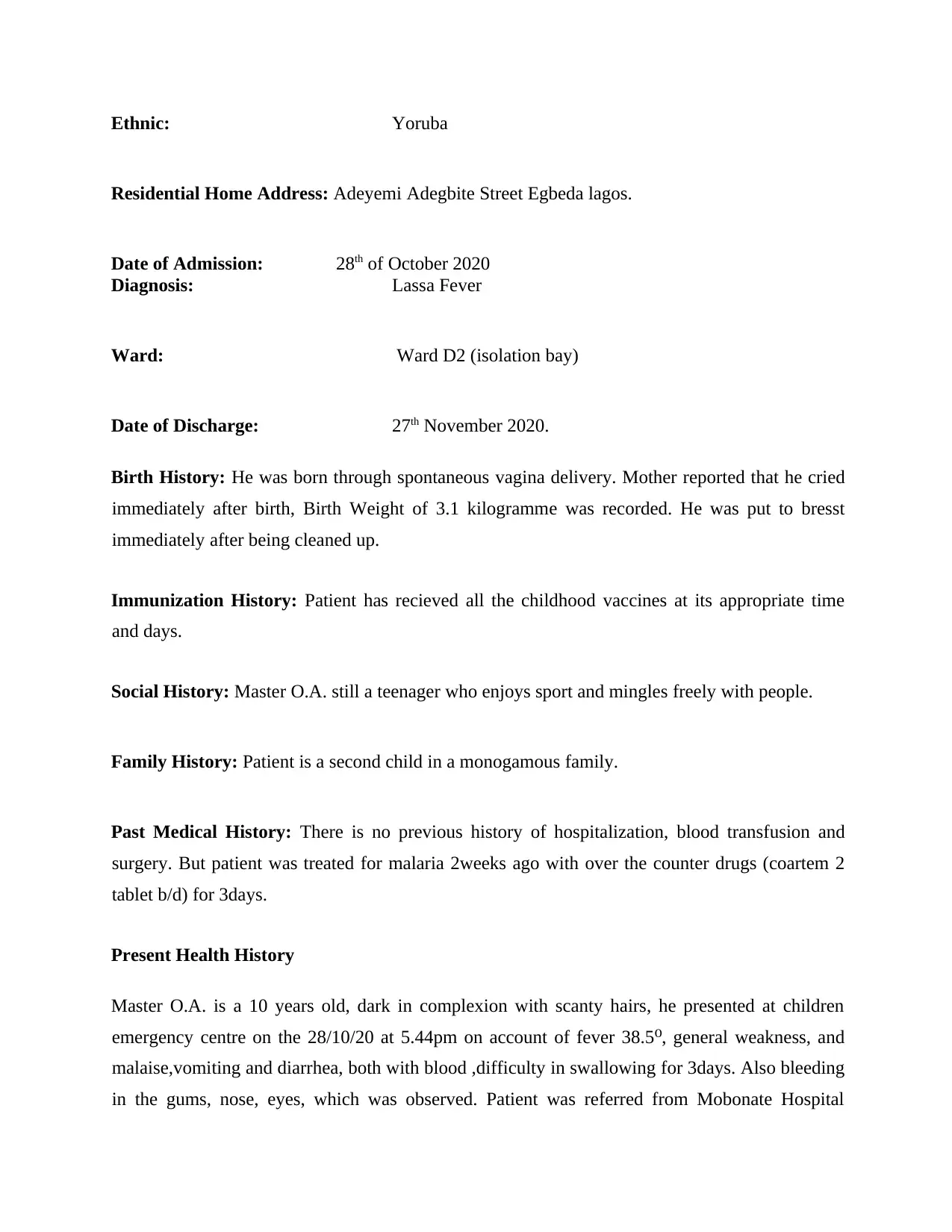
Ethnic: Yoruba
Residential Home Address: Adeyemi Adegbite Street Egbeda lagos.
Date of Admission: 28th of October 2020
Diagnosis: Lassa Fever
Ward: Ward D2 (isolation bay)
Date of Discharge: 27th November 2020.
Birth History: He was born through spontaneous vagina delivery. Mother reported that he cried
immediately after birth, Birth Weight of 3.1 kilogramme was recorded. He was put to bresst
immediately after being cleaned up.
Immunization History: Patient has recieved all the childhood vaccines at its appropriate time
and days.
Social History: Master O.A. still a teenager who enjoys sport and mingles freely with people.
Family History: Patient is a second child in a monogamous family.
Past Medical History: There is no previous history of hospitalization, blood transfusion and
surgery. But patient was treated for malaria 2weeks ago with over the counter drugs (coartem 2
tablet b/d) for 3days.
Present Health History
Master O.A. is a 10 years old, dark in complexion with scanty hairs, he presented at children
emergency centre on the 28/10/20 at 5.44pm on account of fever 38.5 , general weakness, and⁰
malaise,vomiting and diarrhea, both with blood ,difficulty in swallowing for 3days. Also bleeding
in the gums, nose, eyes, which was observed. Patient was referred from Mobonate Hospital
Residential Home Address: Adeyemi Adegbite Street Egbeda lagos.
Date of Admission: 28th of October 2020
Diagnosis: Lassa Fever
Ward: Ward D2 (isolation bay)
Date of Discharge: 27th November 2020.
Birth History: He was born through spontaneous vagina delivery. Mother reported that he cried
immediately after birth, Birth Weight of 3.1 kilogramme was recorded. He was put to bresst
immediately after being cleaned up.
Immunization History: Patient has recieved all the childhood vaccines at its appropriate time
and days.
Social History: Master O.A. still a teenager who enjoys sport and mingles freely with people.
Family History: Patient is a second child in a monogamous family.
Past Medical History: There is no previous history of hospitalization, blood transfusion and
surgery. But patient was treated for malaria 2weeks ago with over the counter drugs (coartem 2
tablet b/d) for 3days.
Present Health History
Master O.A. is a 10 years old, dark in complexion with scanty hairs, he presented at children
emergency centre on the 28/10/20 at 5.44pm on account of fever 38.5 , general weakness, and⁰
malaise,vomiting and diarrhea, both with blood ,difficulty in swallowing for 3days. Also bleeding
in the gums, nose, eyes, which was observed. Patient was referred from Mobonate Hospital
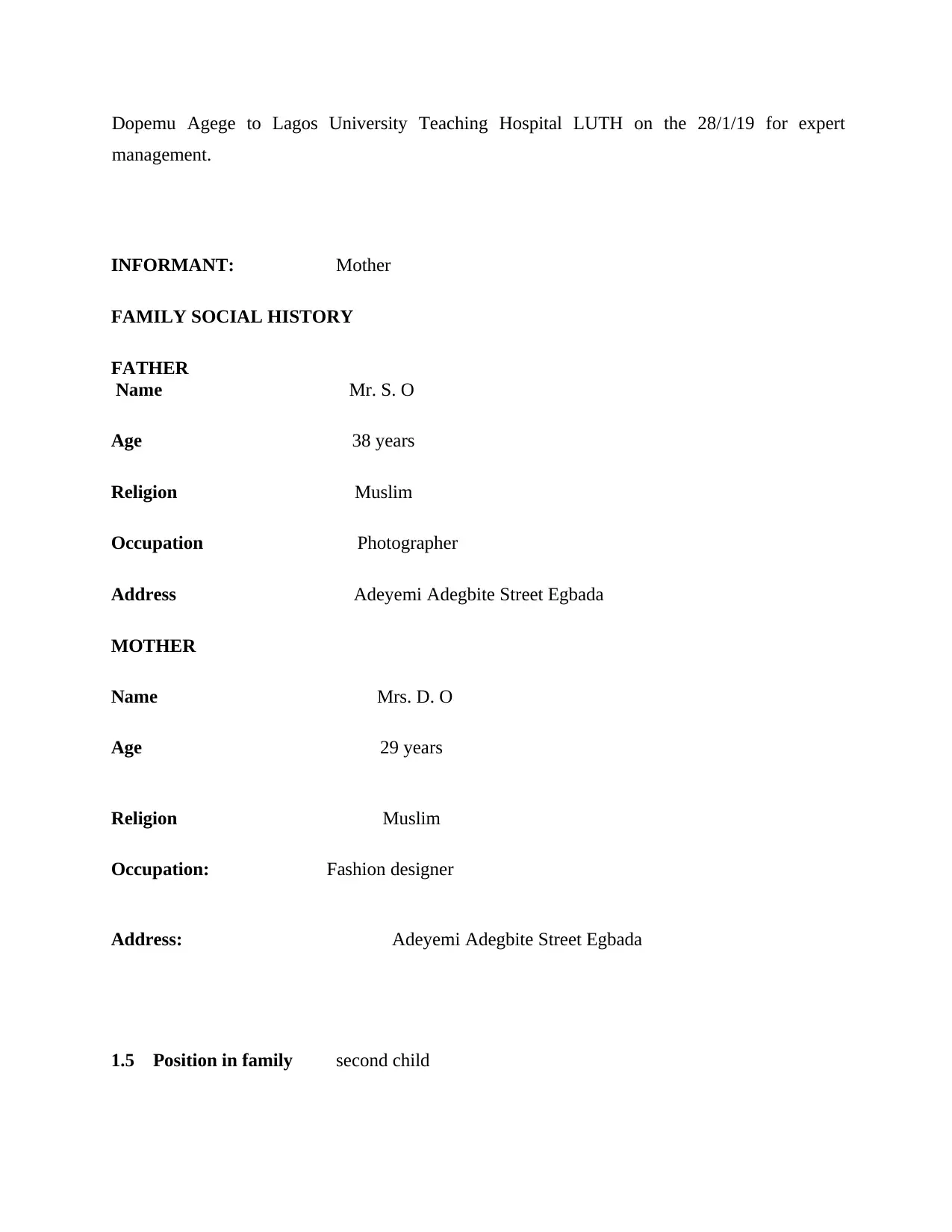
Dopemu Agege to Lagos University Teaching Hospital LUTH on the 28/1/19 for expert
management.
INFORMANT: Mother
FAMILY SOCIAL HISTORY
FATHER
Name Mr. S. O
Age 38 years
Religion Muslim
Occupation Photographer
Address Adeyemi Adegbite Street Egbada
MOTHER
Name Mrs. D. O
Age 29 years
Religion Muslim
Occupation: Fashion designer
Address: Adeyemi Adegbite Street Egbada
1.5 Position in family second child
management.
INFORMANT: Mother
FAMILY SOCIAL HISTORY
FATHER
Name Mr. S. O
Age 38 years
Religion Muslim
Occupation Photographer
Address Adeyemi Adegbite Street Egbada
MOTHER
Name Mrs. D. O
Age 29 years
Religion Muslim
Occupation: Fashion designer
Address: Adeyemi Adegbite Street Egbada
1.5 Position in family second child
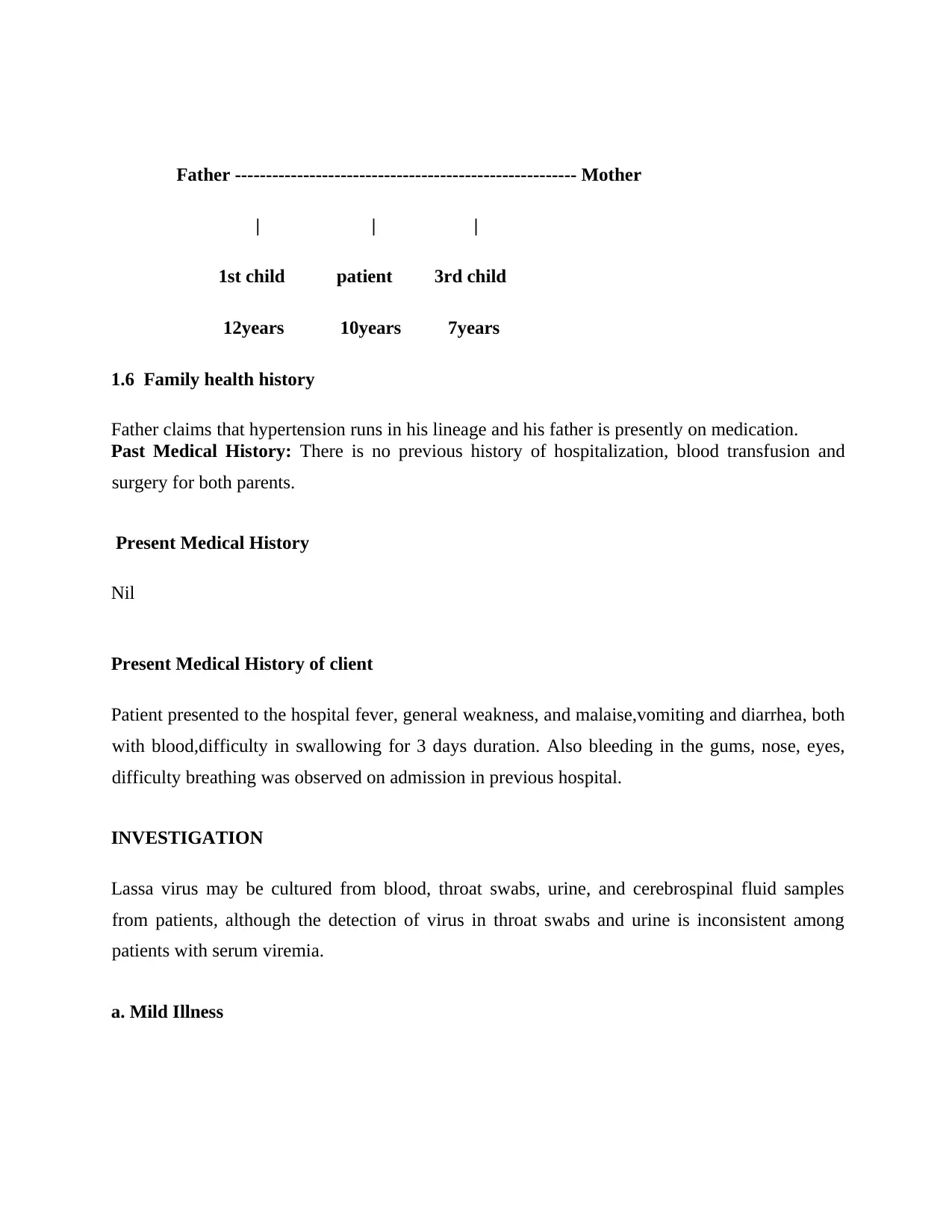
Father -----‐------------------------------------------------- Mother
| | |
1st child patient 3rd child
12years 10years 7years
1.6 Family health history
Father claims that hypertension runs in his lineage and his father is presently on medication.
Past Medical History: There is no previous history of hospitalization, blood transfusion and
surgery for both parents.
Present Medical History
Nil
Present Medical History of client
Patient presented to the hospital fever, general weakness, and malaise,vomiting and diarrhea, both
with blood,difficulty in swallowing for 3 days duration. Also bleeding in the gums, nose, eyes,
difficulty breathing was observed on admission in previous hospital.
INVESTIGATION
Lassa virus may be cultured from blood, throat swabs, urine, and cerebrospinal fluid samples
from patients, although the detection of virus in throat swabs and urine is inconsistent among
patients with serum viremia.
a. Mild Illness
| | |
1st child patient 3rd child
12years 10years 7years
1.6 Family health history
Father claims that hypertension runs in his lineage and his father is presently on medication.
Past Medical History: There is no previous history of hospitalization, blood transfusion and
surgery for both parents.
Present Medical History
Nil
Present Medical History of client
Patient presented to the hospital fever, general weakness, and malaise,vomiting and diarrhea, both
with blood,difficulty in swallowing for 3 days duration. Also bleeding in the gums, nose, eyes,
difficulty breathing was observed on admission in previous hospital.
INVESTIGATION
Lassa virus may be cultured from blood, throat swabs, urine, and cerebrospinal fluid samples
from patients, although the detection of virus in throat swabs and urine is inconsistent among
patients with serum viremia.
a. Mild Illness
Secure Best Marks with AI Grader
Need help grading? Try our AI Grader for instant feedback on your assignments.
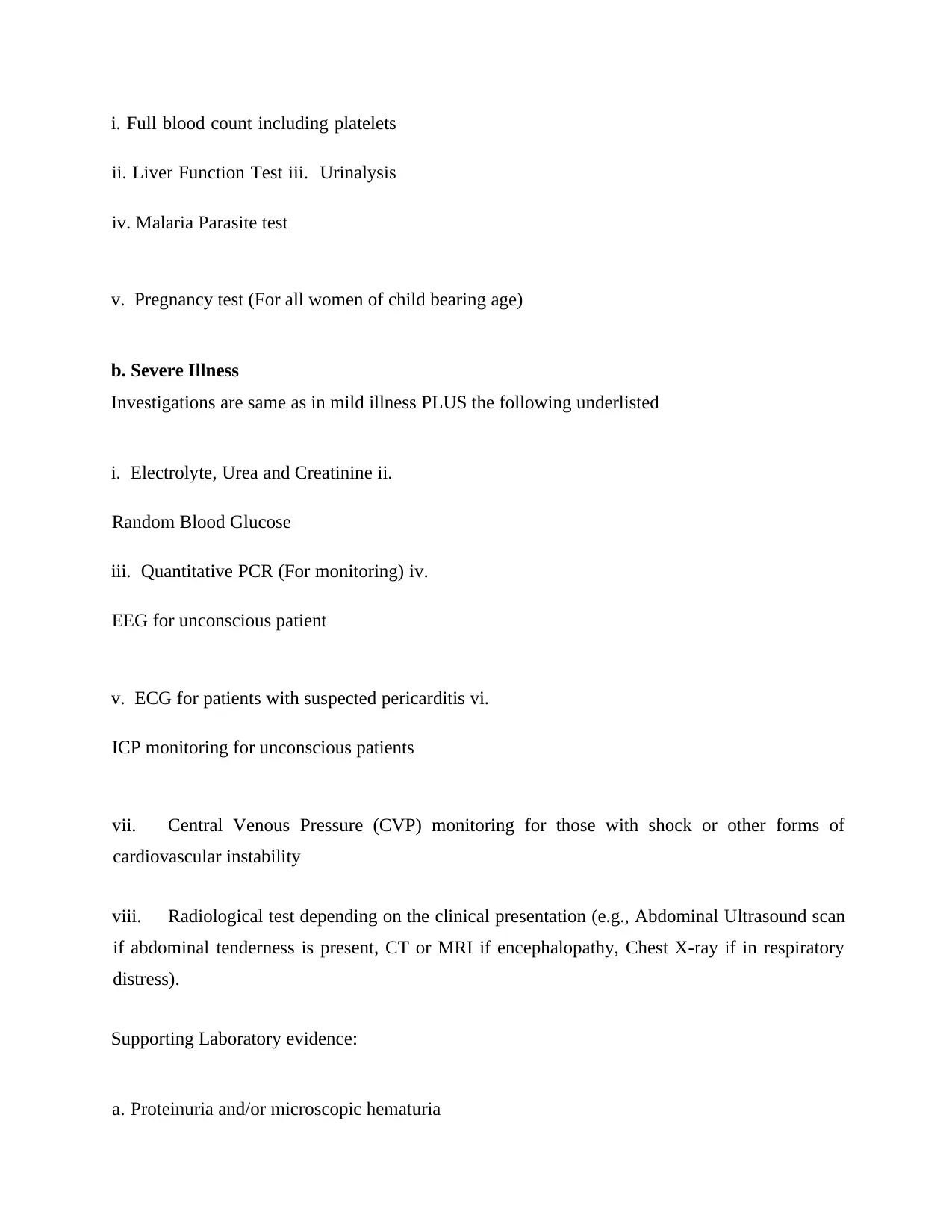
i. Full blood count including platelets
ii. Liver Function Test iii. Urinalysis
iv. Malaria Parasite test
v. Pregnancy test (For all women of child bearing age)
b. Severe Illness
Investigations are same as in mild illness PLUS the following underlisted
i. Electrolyte, Urea and Creatinine ii.
Random Blood Glucose
iii. Quantitative PCR (For monitoring) iv.
EEG for unconscious patient
v. ECG for patients with suspected pericarditis vi.
ICP monitoring for unconscious patients
vii. Central Venous Pressure (CVP) monitoring for those with shock or other forms of
cardiovascular instability
viii. Radiological test depending on the clinical presentation (e.g., Abdominal Ultrasound scan
if abdominal tenderness is present, CT or MRI if encephalopathy, Chest X-ray if in respiratory
distress).
Supporting Laboratory evidence:
a. Proteinuria and/or microscopic hematuria
ii. Liver Function Test iii. Urinalysis
iv. Malaria Parasite test
v. Pregnancy test (For all women of child bearing age)
b. Severe Illness
Investigations are same as in mild illness PLUS the following underlisted
i. Electrolyte, Urea and Creatinine ii.
Random Blood Glucose
iii. Quantitative PCR (For monitoring) iv.
EEG for unconscious patient
v. ECG for patients with suspected pericarditis vi.
ICP monitoring for unconscious patients
vii. Central Venous Pressure (CVP) monitoring for those with shock or other forms of
cardiovascular instability
viii. Radiological test depending on the clinical presentation (e.g., Abdominal Ultrasound scan
if abdominal tenderness is present, CT or MRI if encephalopathy, Chest X-ray if in respiratory
distress).
Supporting Laboratory evidence:
a. Proteinuria and/or microscopic hematuria
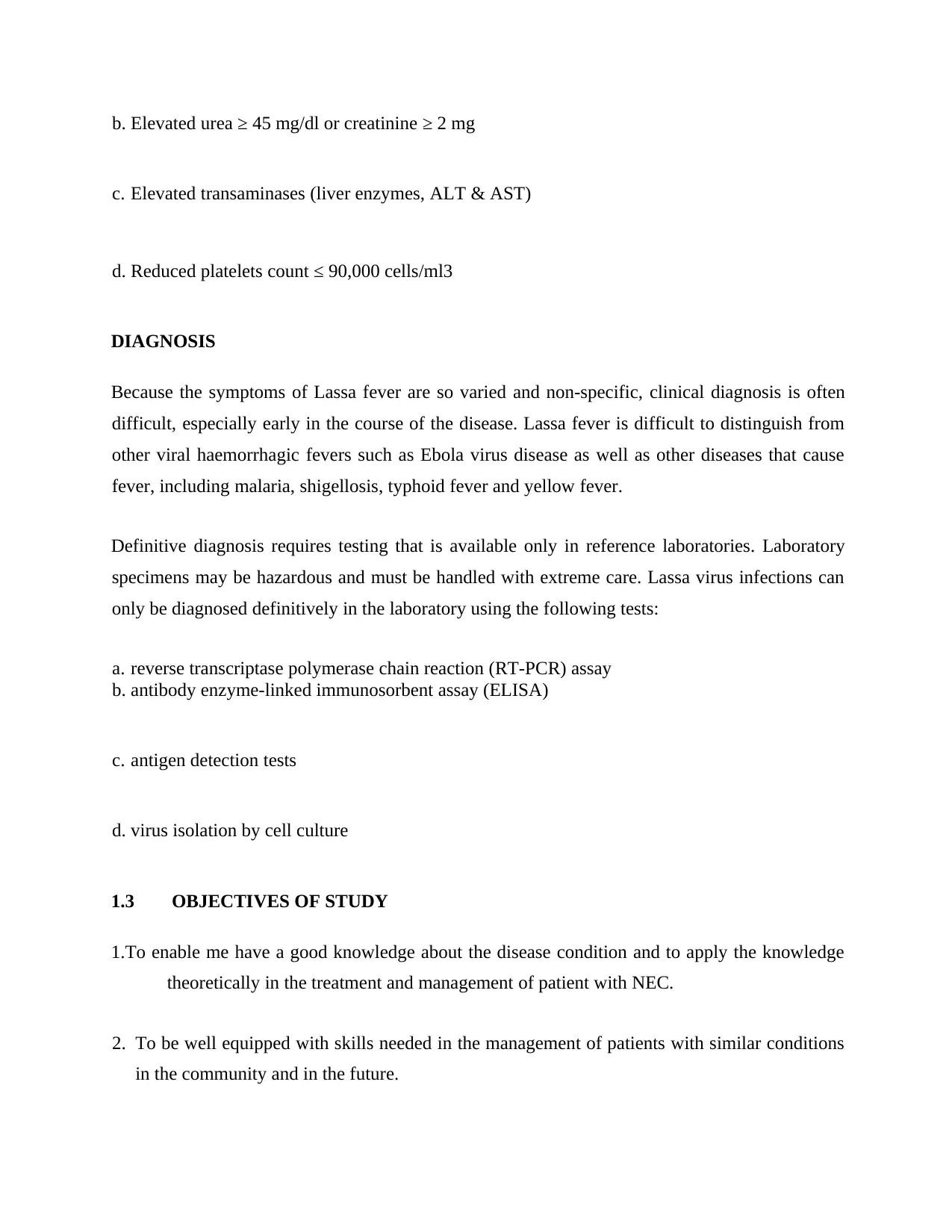
b. Elevated urea ≥ 45 mg/dl or creatinine ≥ 2 mg
c. Elevated transaminases (liver enzymes, ALT & AST)
d. Reduced platelets count ≤ 90,000 cells/ml3
DIAGNOSIS
Because the symptoms of Lassa fever are so varied and non-specific, clinical diagnosis is often
difficult, especially early in the course of the disease. Lassa fever is difficult to distinguish from
other viral haemorrhagic fevers such as Ebola virus disease as well as other diseases that cause
fever, including malaria, shigellosis, typhoid fever and yellow fever.
Definitive diagnosis requires testing that is available only in reference laboratories. Laboratory
specimens may be hazardous and must be handled with extreme care. Lassa virus infections can
only be diagnosed definitively in the laboratory using the following tests:
a. reverse transcriptase polymerase chain reaction (RT-PCR) assay
b. antibody enzyme-linked immunosorbent assay (ELISA)
c. antigen detection tests
d. virus isolation by cell culture
1.3 OBJECTIVES OF STUDY
1.To enable me have a good knowledge about the disease condition and to apply the knowledge
theoretically in the treatment and management of patient with NEC.
2. To be well equipped with skills needed in the management of patients with similar conditions
in the community and in the future.
c. Elevated transaminases (liver enzymes, ALT & AST)
d. Reduced platelets count ≤ 90,000 cells/ml3
DIAGNOSIS
Because the symptoms of Lassa fever are so varied and non-specific, clinical diagnosis is often
difficult, especially early in the course of the disease. Lassa fever is difficult to distinguish from
other viral haemorrhagic fevers such as Ebola virus disease as well as other diseases that cause
fever, including malaria, shigellosis, typhoid fever and yellow fever.
Definitive diagnosis requires testing that is available only in reference laboratories. Laboratory
specimens may be hazardous and must be handled with extreme care. Lassa virus infections can
only be diagnosed definitively in the laboratory using the following tests:
a. reverse transcriptase polymerase chain reaction (RT-PCR) assay
b. antibody enzyme-linked immunosorbent assay (ELISA)
c. antigen detection tests
d. virus isolation by cell culture
1.3 OBJECTIVES OF STUDY
1.To enable me have a good knowledge about the disease condition and to apply the knowledge
theoretically in the treatment and management of patient with NEC.
2. To be well equipped with skills needed in the management of patients with similar conditions
in the community and in the future.

3. To educate people on disease condition which will include the causes management and
prognosis of the disease.
4. To identify problems and develop a comprehensive care plan on the disease condition.
5. To create a lasting relationship with family in the management and care of the child.
prognosis of the disease.
4. To identify problems and develop a comprehensive care plan on the disease condition.
5. To create a lasting relationship with family in the management and care of the child.
Paraphrase This Document
Need a fresh take? Get an instant paraphrase of this document with our AI Paraphraser
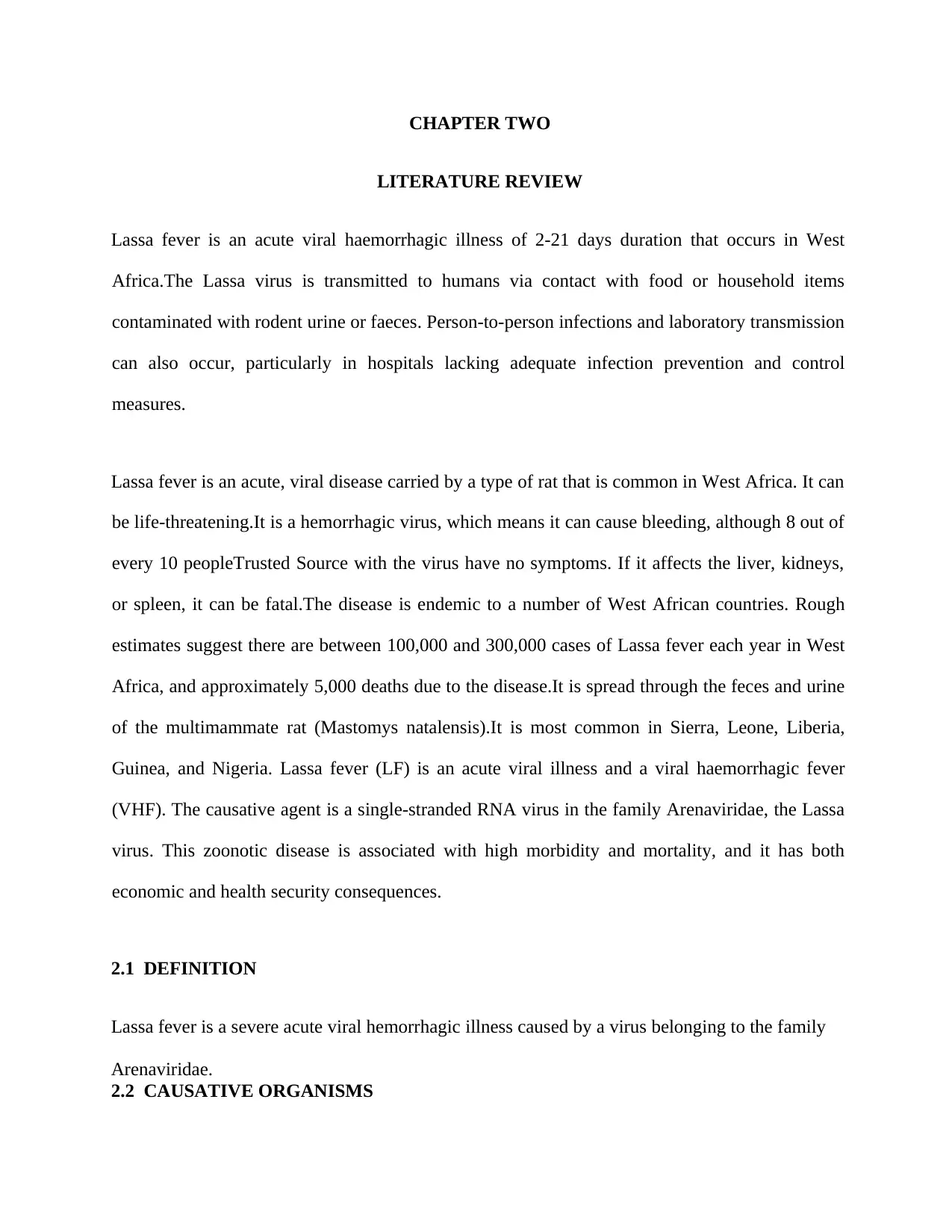
CHAPTER TWO
LITERATURE REVIEW
Lassa fever is an acute viral haemorrhagic illness of 2-21 days duration that occurs in West
Africa.The Lassa virus is transmitted to humans via contact with food or household items
contaminated with rodent urine or faeces. Person-to-person infections and laboratory transmission
can also occur, particularly in hospitals lacking adequate infection prevention and control
measures.
Lassa fever is an acute, viral disease carried by a type of rat that is common in West Africa. It can
be life-threatening.It is a hemorrhagic virus, which means it can cause bleeding, although 8 out of
every 10 peopleTrusted Source with the virus have no symptoms. If it affects the liver, kidneys,
or spleen, it can be fatal.The disease is endemic to a number of West African countries. Rough
estimates suggest there are between 100,000 and 300,000 cases of Lassa fever each year in West
Africa, and approximately 5,000 deaths due to the disease.It is spread through the feces and urine
of the multimammate rat (Mastomys natalensis).It is most common in Sierra, Leone, Liberia,
Guinea, and Nigeria. Lassa fever (LF) is an acute viral illness and a viral haemorrhagic fever
(VHF). The causative agent is a single-stranded RNA virus in the family Arenaviridae, the Lassa
virus. This zoonotic disease is associated with high morbidity and mortality, and it has both
economic and health security consequences.
2.1 DEFINITION
Lassa fever is a severe acute viral hemorrhagic illness caused by a virus belonging to the family
Arenaviridae.
2.2 CAUSATIVE ORGANISMS
LITERATURE REVIEW
Lassa fever is an acute viral haemorrhagic illness of 2-21 days duration that occurs in West
Africa.The Lassa virus is transmitted to humans via contact with food or household items
contaminated with rodent urine or faeces. Person-to-person infections and laboratory transmission
can also occur, particularly in hospitals lacking adequate infection prevention and control
measures.
Lassa fever is an acute, viral disease carried by a type of rat that is common in West Africa. It can
be life-threatening.It is a hemorrhagic virus, which means it can cause bleeding, although 8 out of
every 10 peopleTrusted Source with the virus have no symptoms. If it affects the liver, kidneys,
or spleen, it can be fatal.The disease is endemic to a number of West African countries. Rough
estimates suggest there are between 100,000 and 300,000 cases of Lassa fever each year in West
Africa, and approximately 5,000 deaths due to the disease.It is spread through the feces and urine
of the multimammate rat (Mastomys natalensis).It is most common in Sierra, Leone, Liberia,
Guinea, and Nigeria. Lassa fever (LF) is an acute viral illness and a viral haemorrhagic fever
(VHF). The causative agent is a single-stranded RNA virus in the family Arenaviridae, the Lassa
virus. This zoonotic disease is associated with high morbidity and mortality, and it has both
economic and health security consequences.
2.1 DEFINITION
Lassa fever is a severe acute viral hemorrhagic illness caused by a virus belonging to the family
Arenaviridae.
2.2 CAUSATIVE ORGANISMS

Single-stranded RNA virus in the family Arenaviridae, the Lassa virus.
2.3 MODE OF TRANSMISSION
1. The Lassa virus is transmitted to man by infected multi-mammate rats, the mastomys natalensis
species complex which is the reservoir host. Once a Mastomys rat is infected with the virus, it
can excrete the virus in its feces and urine, potentially for the rest of its life.As a result, the
virus can spread easily, especially as the rats breed rapidly and can inhabit human homes.
2. The most common method of transmission is by consuming or inhaling rat urine or feces. It
can also be spread through cuts and open sores.
3. The rats live in and around human habitation, and they often come into contact with foodstuffs.
Sometimes people eat the rats, and the disease can be spread during their preparation.
4. Person-to-person contact is possible via blood, tissue, secretions or excretions, but not through
touch. Sharing needles may spread the virus, and there are some reports of sexual transmission.
5. Lassa fever can also be passed between patients and staff at poorly equipped hospitals where
sterilization and protective clothing is not standard.
2.4 INCUBATION PERIOD
The incubation period is between 6-21 days.
2.5 CLINICAL MANIFESTATIONS
2.3 MODE OF TRANSMISSION
1. The Lassa virus is transmitted to man by infected multi-mammate rats, the mastomys natalensis
species complex which is the reservoir host. Once a Mastomys rat is infected with the virus, it
can excrete the virus in its feces and urine, potentially for the rest of its life.As a result, the
virus can spread easily, especially as the rats breed rapidly and can inhabit human homes.
2. The most common method of transmission is by consuming or inhaling rat urine or feces. It
can also be spread through cuts and open sores.
3. The rats live in and around human habitation, and they often come into contact with foodstuffs.
Sometimes people eat the rats, and the disease can be spread during their preparation.
4. Person-to-person contact is possible via blood, tissue, secretions or excretions, but not through
touch. Sharing needles may spread the virus, and there are some reports of sexual transmission.
5. Lassa fever can also be passed between patients and staff at poorly equipped hospitals where
sterilization and protective clothing is not standard.
2.4 INCUBATION PERIOD
The incubation period is between 6-21 days.
2.5 CLINICAL MANIFESTATIONS
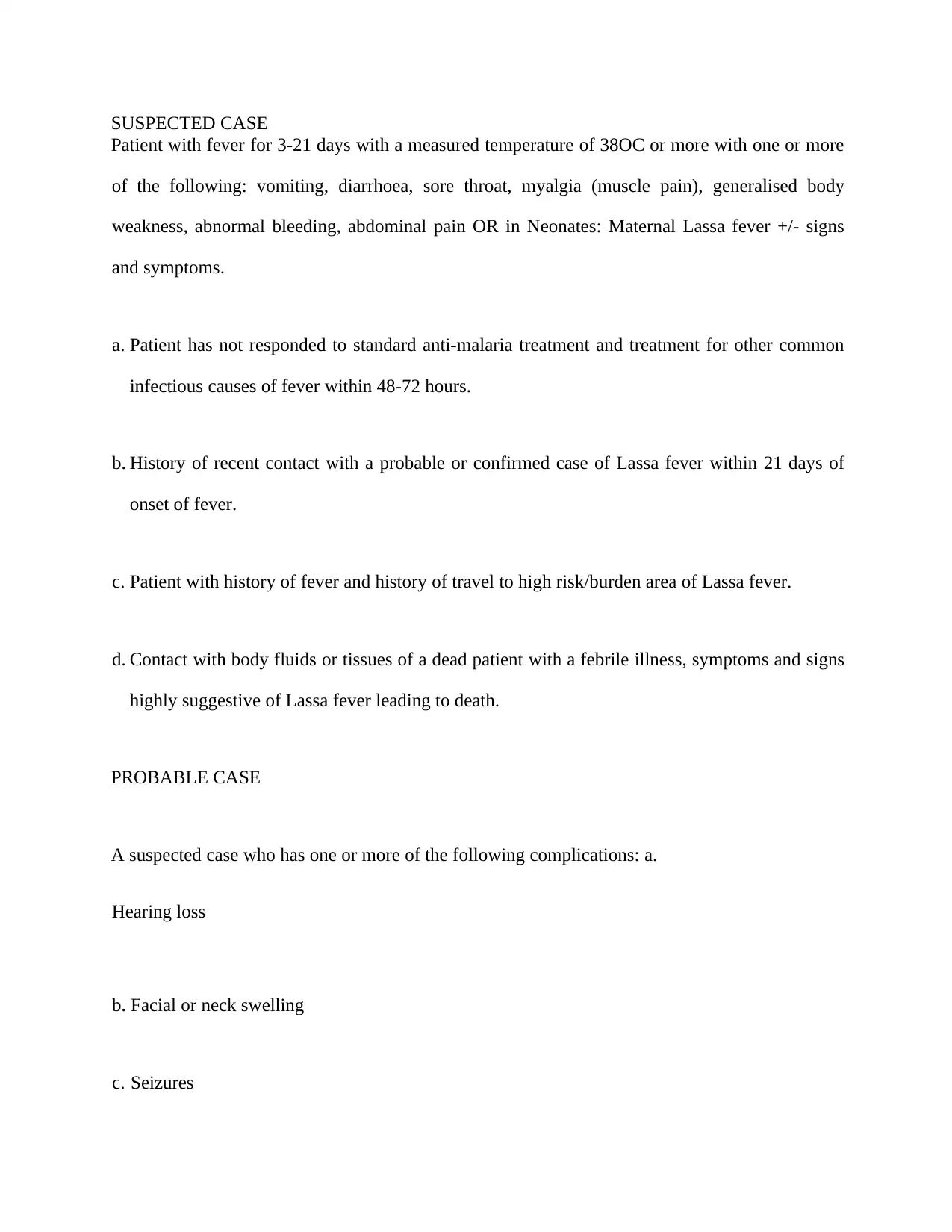
SUSPECTED CASE
Patient with fever for 3-21 days with a measured temperature of 38OC or more with one or more
of the following: vomiting, diarrhoea, sore throat, myalgia (muscle pain), generalised body
weakness, abnormal bleeding, abdominal pain OR in Neonates: Maternal Lassa fever +/- signs
and symptoms.
a. Patient has not responded to standard anti-malaria treatment and treatment for other common
infectious causes of fever within 48-72 hours.
b. History of recent contact with a probable or confirmed case of Lassa fever within 21 days of
onset of fever.
c. Patient with history of fever and history of travel to high risk/burden area of Lassa fever.
d. Contact with body fluids or tissues of a dead patient with a febrile illness, symptoms and signs
highly suggestive of Lassa fever leading to death.
PROBABLE CASE
A suspected case who has one or more of the following complications: a.
Hearing loss
b. Facial or neck swelling
c. Seizures
Patient with fever for 3-21 days with a measured temperature of 38OC or more with one or more
of the following: vomiting, diarrhoea, sore throat, myalgia (muscle pain), generalised body
weakness, abnormal bleeding, abdominal pain OR in Neonates: Maternal Lassa fever +/- signs
and symptoms.
a. Patient has not responded to standard anti-malaria treatment and treatment for other common
infectious causes of fever within 48-72 hours.
b. History of recent contact with a probable or confirmed case of Lassa fever within 21 days of
onset of fever.
c. Patient with history of fever and history of travel to high risk/burden area of Lassa fever.
d. Contact with body fluids or tissues of a dead patient with a febrile illness, symptoms and signs
highly suggestive of Lassa fever leading to death.
PROBABLE CASE
A suspected case who has one or more of the following complications: a.
Hearing loss
b. Facial or neck swelling
c. Seizures
Secure Best Marks with AI Grader
Need help grading? Try our AI Grader for instant feedback on your assignments.
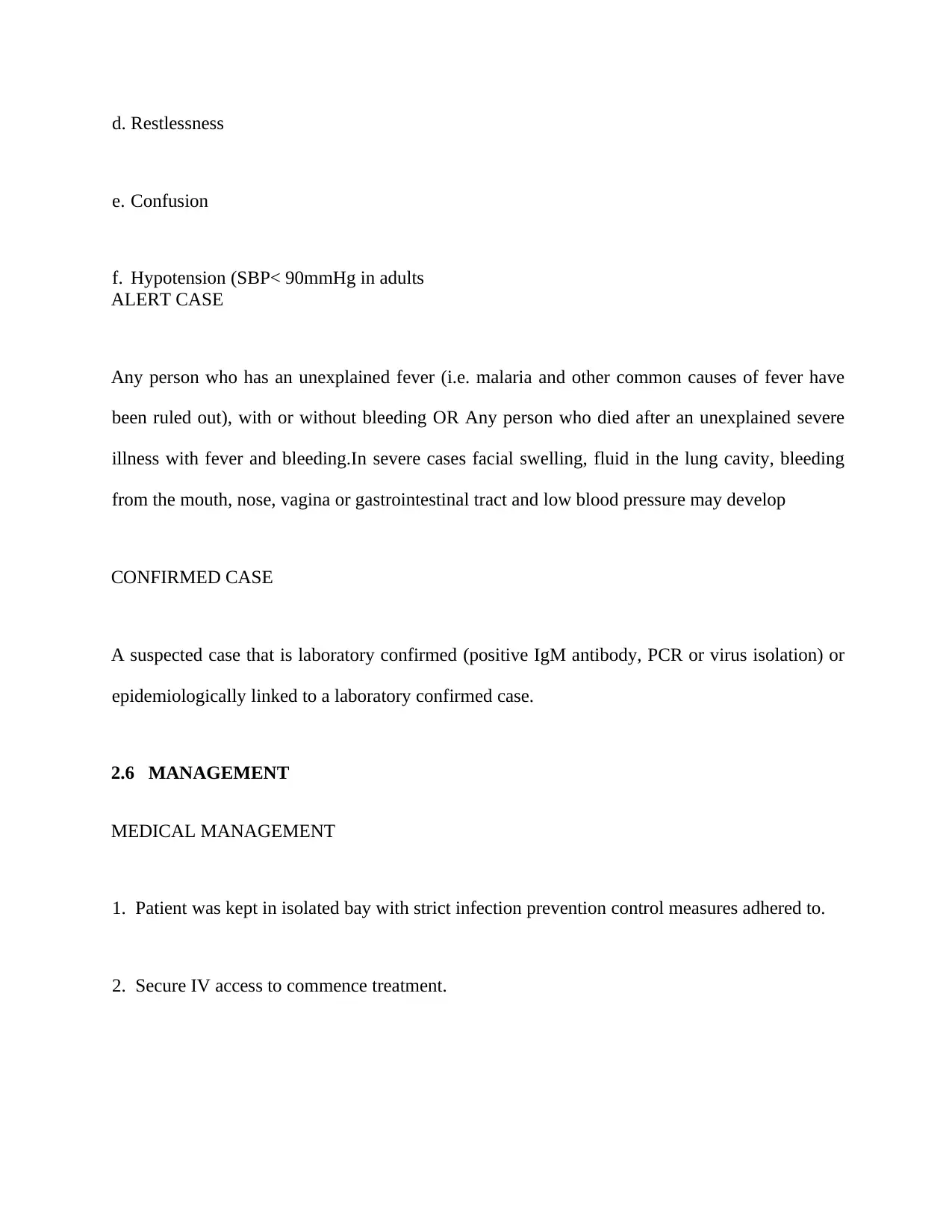
d. Restlessness
e. Confusion
f. Hypotension (SBP< 90mmHg in adults
ALERT CASE
Any person who has an unexplained fever (i.e. malaria and other common causes of fever have
been ruled out), with or without bleeding OR Any person who died after an unexplained severe
illness with fever and bleeding.In severe cases facial swelling, fluid in the lung cavity, bleeding
from the mouth, nose, vagina or gastrointestinal tract and low blood pressure may develop
CONFIRMED CASE
A suspected case that is laboratory confirmed (positive IgM antibody, PCR or virus isolation) or
epidemiologically linked to a laboratory confirmed case.
2.6 MANAGEMENT
MEDICAL MANAGEMENT
1. Patient was kept in isolated bay with strict infection prevention control measures adhered to.
2. Secure IV access to commence treatment.
e. Confusion
f. Hypotension (SBP< 90mmHg in adults
ALERT CASE
Any person who has an unexplained fever (i.e. malaria and other common causes of fever have
been ruled out), with or without bleeding OR Any person who died after an unexplained severe
illness with fever and bleeding.In severe cases facial swelling, fluid in the lung cavity, bleeding
from the mouth, nose, vagina or gastrointestinal tract and low blood pressure may develop
CONFIRMED CASE
A suspected case that is laboratory confirmed (positive IgM antibody, PCR or virus isolation) or
epidemiologically linked to a laboratory confirmed case.
2.6 MANAGEMENT
MEDICAL MANAGEMENT
1. Patient was kept in isolated bay with strict infection prevention control measures adhered to.
2. Secure IV access to commence treatment.
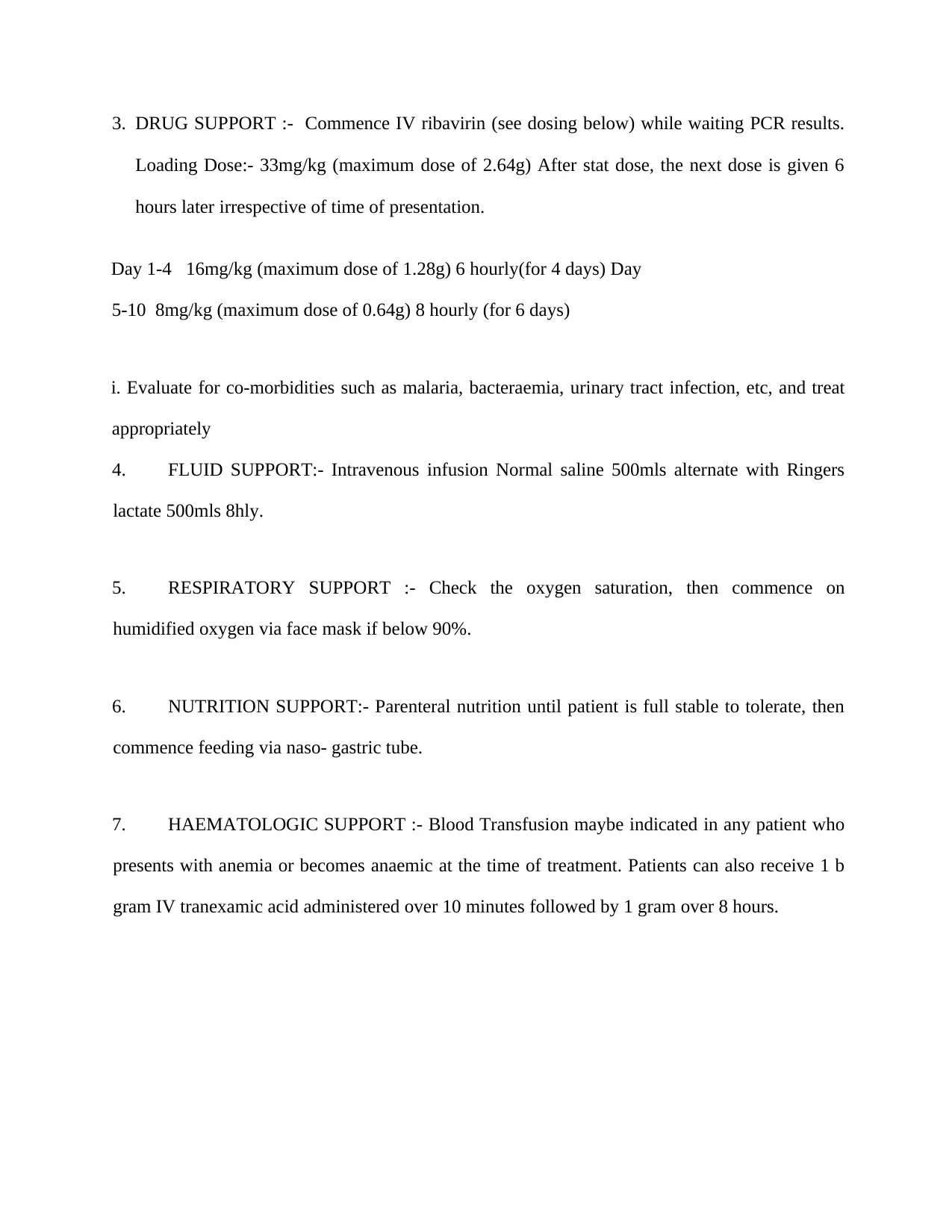
3. DRUG SUPPORT :- Commence IV ribavirin (see dosing below) while waiting PCR results.
Loading Dose:- 33mg/kg (maximum dose of 2.64g) After stat dose, the next dose is given 6
hours later irrespective of time of presentation.
Day 1-4 16mg/kg (maximum dose of 1.28g) 6 hourly(for 4 days) Day
5-10 8mg/kg (maximum dose of 0.64g) 8 hourly (for 6 days)
i. Evaluate for co-morbidities such as malaria, bacteraemia, urinary tract infection, etc, and treat
appropriately
4. FLUID SUPPORT:- Intravenous infusion Normal saline 500mls alternate with Ringers
lactate 500mls 8hly.
5. RESPIRATORY SUPPORT :- Check the oxygen saturation, then commence on
humidified oxygen via face mask if below 90%.
6. NUTRITION SUPPORT:- Parenteral nutrition until patient is full stable to tolerate, then
commence feeding via naso- gastric tube.
7. HAEMATOLOGIC SUPPORT :- Blood Transfusion maybe indicated in any patient who
presents with anemia or becomes anaemic at the time of treatment. Patients can also receive 1 b
gram IV tranexamic acid administered over 10 minutes followed by 1 gram over 8 hours.
Loading Dose:- 33mg/kg (maximum dose of 2.64g) After stat dose, the next dose is given 6
hours later irrespective of time of presentation.
Day 1-4 16mg/kg (maximum dose of 1.28g) 6 hourly(for 4 days) Day
5-10 8mg/kg (maximum dose of 0.64g) 8 hourly (for 6 days)
i. Evaluate for co-morbidities such as malaria, bacteraemia, urinary tract infection, etc, and treat
appropriately
4. FLUID SUPPORT:- Intravenous infusion Normal saline 500mls alternate with Ringers
lactate 500mls 8hly.
5. RESPIRATORY SUPPORT :- Check the oxygen saturation, then commence on
humidified oxygen via face mask if below 90%.
6. NUTRITION SUPPORT:- Parenteral nutrition until patient is full stable to tolerate, then
commence feeding via naso- gastric tube.
7. HAEMATOLOGIC SUPPORT :- Blood Transfusion maybe indicated in any patient who
presents with anemia or becomes anaemic at the time of treatment. Patients can also receive 1 b
gram IV tranexamic acid administered over 10 minutes followed by 1 gram over 8 hours.
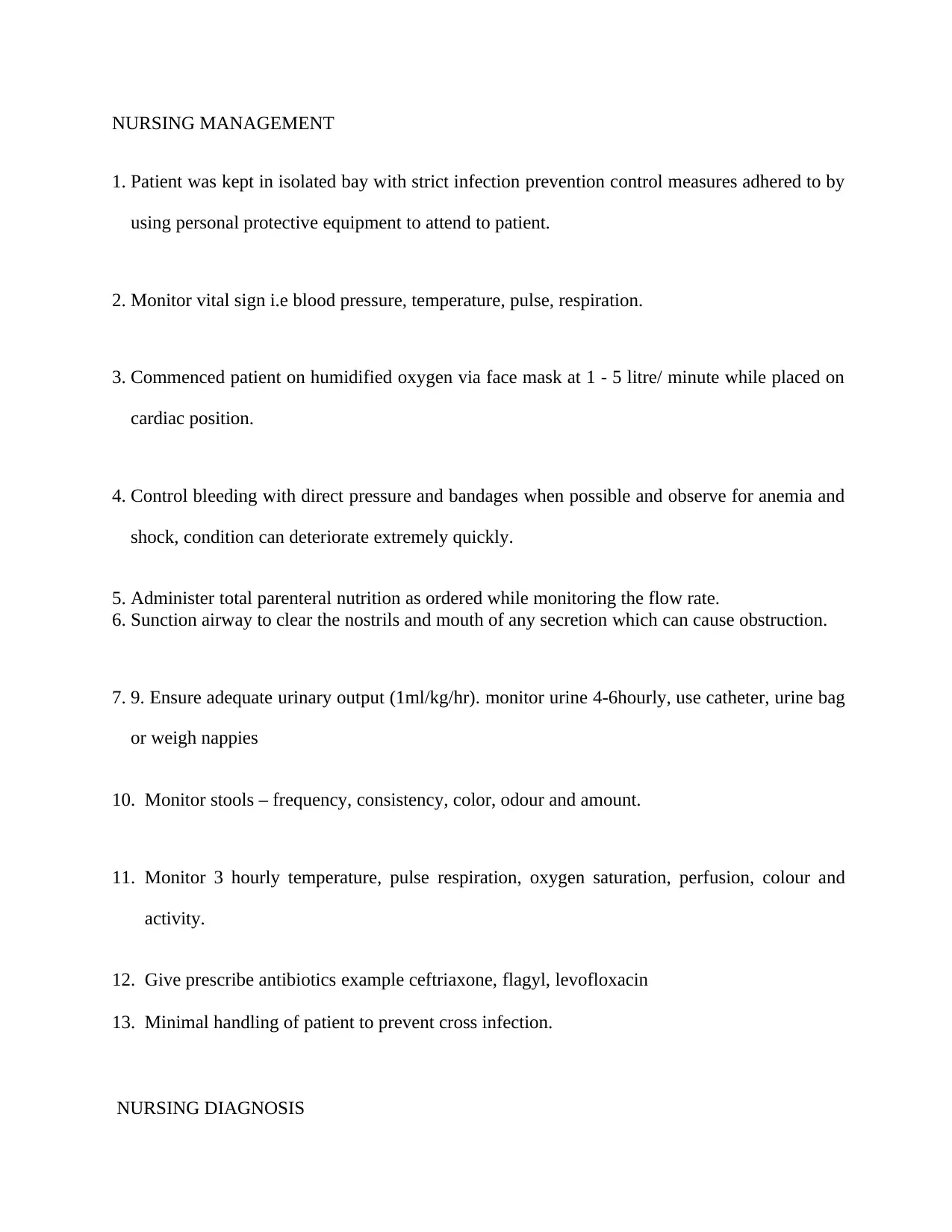
NURSING MANAGEMENT
1. Patient was kept in isolated bay with strict infection prevention control measures adhered to by
using personal protective equipment to attend to patient.
2. Monitor vital sign i.e blood pressure, temperature, pulse, respiration.
3. Commenced patient on humidified oxygen via face mask at 1 - 5 litre/ minute while placed on
cardiac position.
4. Control bleeding with direct pressure and bandages when possible and observe for anemia and
shock, condition can deteriorate extremely quickly.
5. Administer total parenteral nutrition as ordered while monitoring the flow rate.
6. Sunction airway to clear the nostrils and mouth of any secretion which can cause obstruction.
7. 9. Ensure adequate urinary output (1ml/kg/hr). monitor urine 4-6hourly, use catheter, urine bag
or weigh nappies
10. Monitor stools – frequency, consistency, color, odour and amount.
11. Monitor 3 hourly temperature, pulse respiration, oxygen saturation, perfusion, colour and
activity.
12. Give prescribe antibiotics example ceftriaxone, flagyl, levofloxacin
13. Minimal handling of patient to prevent cross infection.
NURSING DIAGNOSIS
1. Patient was kept in isolated bay with strict infection prevention control measures adhered to by
using personal protective equipment to attend to patient.
2. Monitor vital sign i.e blood pressure, temperature, pulse, respiration.
3. Commenced patient on humidified oxygen via face mask at 1 - 5 litre/ minute while placed on
cardiac position.
4. Control bleeding with direct pressure and bandages when possible and observe for anemia and
shock, condition can deteriorate extremely quickly.
5. Administer total parenteral nutrition as ordered while monitoring the flow rate.
6. Sunction airway to clear the nostrils and mouth of any secretion which can cause obstruction.
7. 9. Ensure adequate urinary output (1ml/kg/hr). monitor urine 4-6hourly, use catheter, urine bag
or weigh nappies
10. Monitor stools – frequency, consistency, color, odour and amount.
11. Monitor 3 hourly temperature, pulse respiration, oxygen saturation, perfusion, colour and
activity.
12. Give prescribe antibiotics example ceftriaxone, flagyl, levofloxacin
13. Minimal handling of patient to prevent cross infection.
NURSING DIAGNOSIS
Paraphrase This Document
Need a fresh take? Get an instant paraphrase of this document with our AI Paraphraser

1. Ineffective breathing pattern related to reduce oxygen in circulation evidence by dyspnea.
2. Fluid volume deficit related to loss of active liquid evidence by vomiting and stooling.
3. Hyperthemia related to disturbance in the heat regulating centre of the brain evidence by
temperature of 38.5 .⁰
4. Imbalance nutrition less than body requirements related to decreased food intake.
NURSING CARE PLAN
NAME :- Master O.A
AGE:- 10 years. SEX:- Male.
2. Fluid volume deficit related to loss of active liquid evidence by vomiting and stooling.
3. Hyperthemia related to disturbance in the heat regulating centre of the brain evidence by
temperature of 38.5 .⁰
4. Imbalance nutrition less than body requirements related to decreased food intake.
NURSING CARE PLAN
NAME :- Master O.A
AGE:- 10 years. SEX:- Male.
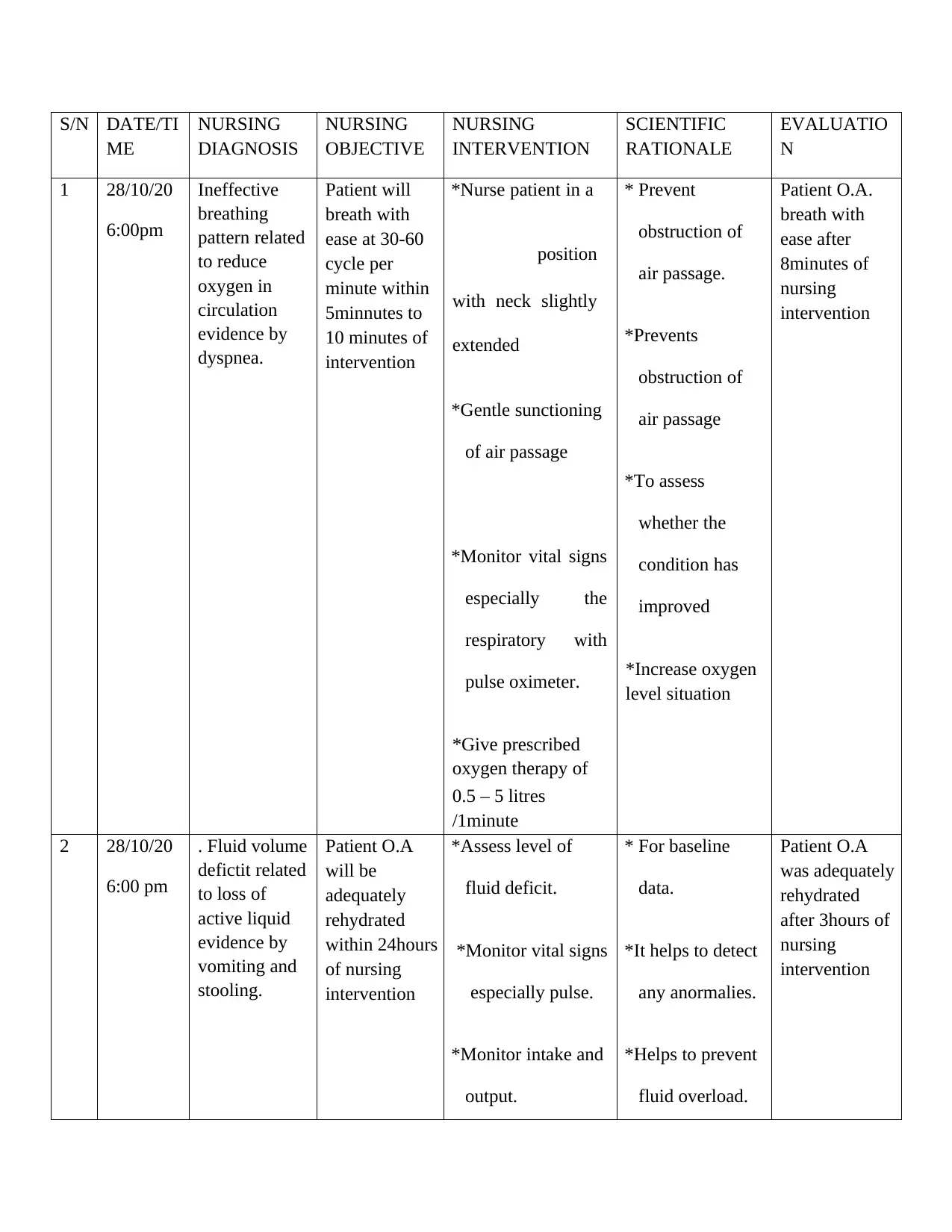
S/N DATE/TI
ME
NURSING
DIAGNOSIS
NURSING
OBJECTIVE
NURSING
INTERVENTION
SCIENTIFIC
RATIONALE
EVALUATIO
N
1 28/10/20
6:00pm
Ineffective
breathing
pattern related
to reduce
oxygen in
circulation
evidence by
dyspnea.
Patient will
breath with
ease at 30-60
cycle per
minute within
5minnutes to
10 minutes of
intervention
*Nurse patient in a
position
with neck slightly
extended
*Gentle sunctioning
of air passage
*Monitor vital signs
especially the
respiratory with
pulse oximeter.
*Give prescribed
oxygen therapy of
0.5 – 5 litres
/1minute
* Prevent
obstruction of
air passage.
*Prevents
obstruction of
air passage
*To assess
whether the
condition has
improved
*Increase oxygen
level situation
Patient O.A.
breath with
ease after
8minutes of
nursing
intervention
2 28/10/20
6:00 pm
. Fluid volume
defictit related
to loss of
active liquid
evidence by
vomiting and
stooling.
Patient O.A
will be
adequately
rehydrated
within 24hours
of nursing
intervention
*Assess level of
fluid deficit.
*Monitor vital signs
especially pulse.
*Monitor intake and
output.
* For baseline
data.
*It helps to detect
any anormalies.
*Helps to prevent
fluid overload.
Patient O.A
was adequately
rehydrated
after 3hours of
nursing
intervention
ME
NURSING
DIAGNOSIS
NURSING
OBJECTIVE
NURSING
INTERVENTION
SCIENTIFIC
RATIONALE
EVALUATIO
N
1 28/10/20
6:00pm
Ineffective
breathing
pattern related
to reduce
oxygen in
circulation
evidence by
dyspnea.
Patient will
breath with
ease at 30-60
cycle per
minute within
5minnutes to
10 minutes of
intervention
*Nurse patient in a
position
with neck slightly
extended
*Gentle sunctioning
of air passage
*Monitor vital signs
especially the
respiratory with
pulse oximeter.
*Give prescribed
oxygen therapy of
0.5 – 5 litres
/1minute
* Prevent
obstruction of
air passage.
*Prevents
obstruction of
air passage
*To assess
whether the
condition has
improved
*Increase oxygen
level situation
Patient O.A.
breath with
ease after
8minutes of
nursing
intervention
2 28/10/20
6:00 pm
. Fluid volume
defictit related
to loss of
active liquid
evidence by
vomiting and
stooling.
Patient O.A
will be
adequately
rehydrated
within 24hours
of nursing
intervention
*Assess level of
fluid deficit.
*Monitor vital signs
especially pulse.
*Monitor intake and
output.
* For baseline
data.
*It helps to detect
any anormalies.
*Helps to prevent
fluid overload.
Patient O.A
was adequately
rehydrated
after 3hours of
nursing
intervention
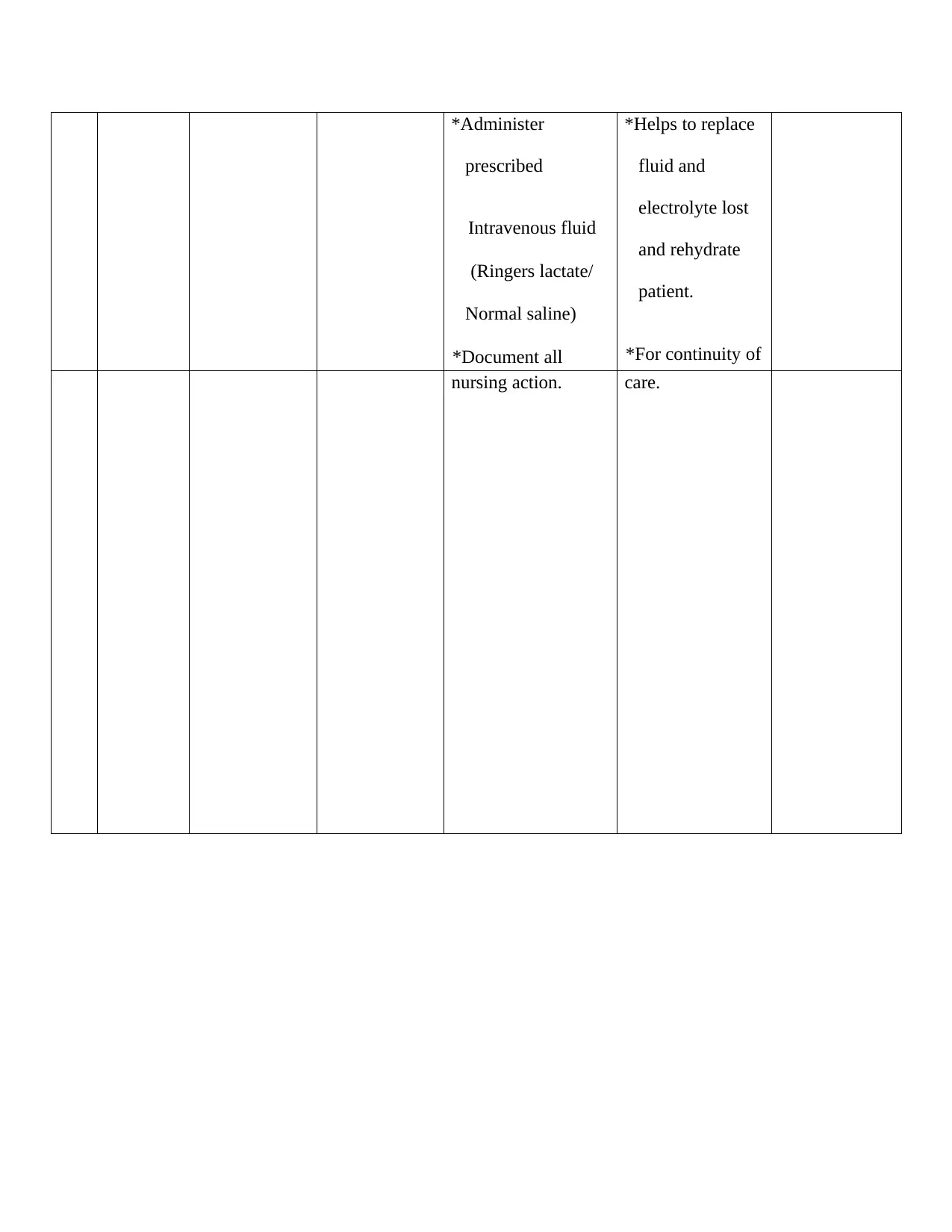
*Administer
prescribed
Intravenous fluid
(Ringers lactate/
Normal saline)
*Document all
*Helps to replace
fluid and
electrolyte lost
and rehydrate
patient.
*For continuity of
nursing action. care.
prescribed
Intravenous fluid
(Ringers lactate/
Normal saline)
*Document all
*Helps to replace
fluid and
electrolyte lost
and rehydrate
patient.
*For continuity of
nursing action. care.
Secure Best Marks with AI Grader
Need help grading? Try our AI Grader for instant feedback on your assignments.
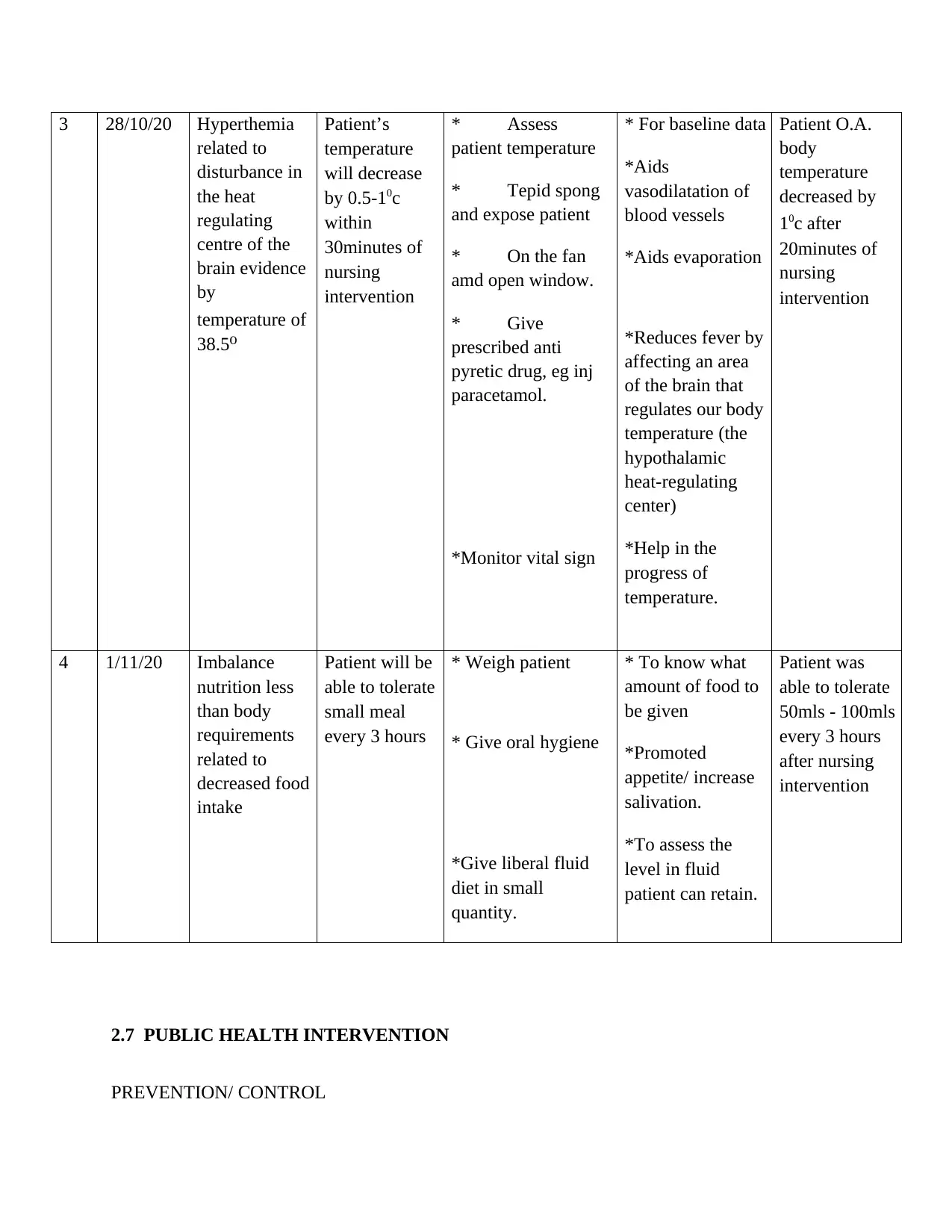
3 28/10/20 Hyperthemia
related to
disturbance in
the heat
regulating
centre of the
brain evidence
by
temperature of
38.5 ⁰
Patient’s
temperature
will decrease
by 0.5-10c
within
30minutes of
nursing
intervention
* Assess
patient temperature
* Tepid spong
and expose patient
* On the fan
amd open window.
* Give
prescribed anti
pyretic drug, eg inj
paracetamol.
*Monitor vital sign
* For baseline data
*Aids
vasodilatation of
blood vessels
*Aids evaporation
*Reduces fever by
affecting an area
of the brain that
regulates our body
temperature (the
hypothalamic
heat-regulating
center)
*Help in the
progress of
temperature.
Patient O.A.
body
temperature
decreased by
10c after
20minutes of
nursing
intervention
4 1/11/20 Imbalance
nutrition less
than body
requirements
related to
decreased food
intake
Patient will be
able to tolerate
small meal
every 3 hours
* Weigh patient
* Give oral hygiene
*Give liberal fluid
diet in small
quantity.
* To know what
amount of food to
be given
*Promoted
appetite/ increase
salivation.
*To assess the
level in fluid
patient can retain.
Patient was
able to tolerate
50mls - 100mls
every 3 hours
after nursing
intervention
2.7 PUBLIC HEALTH INTERVENTION
PREVENTION/ CONTROL
related to
disturbance in
the heat
regulating
centre of the
brain evidence
by
temperature of
38.5 ⁰
Patient’s
temperature
will decrease
by 0.5-10c
within
30minutes of
nursing
intervention
* Assess
patient temperature
* Tepid spong
and expose patient
* On the fan
amd open window.
* Give
prescribed anti
pyretic drug, eg inj
paracetamol.
*Monitor vital sign
* For baseline data
*Aids
vasodilatation of
blood vessels
*Aids evaporation
*Reduces fever by
affecting an area
of the brain that
regulates our body
temperature (the
hypothalamic
heat-regulating
center)
*Help in the
progress of
temperature.
Patient O.A.
body
temperature
decreased by
10c after
20minutes of
nursing
intervention
4 1/11/20 Imbalance
nutrition less
than body
requirements
related to
decreased food
intake
Patient will be
able to tolerate
small meal
every 3 hours
* Weigh patient
* Give oral hygiene
*Give liberal fluid
diet in small
quantity.
* To know what
amount of food to
be given
*Promoted
appetite/ increase
salivation.
*To assess the
level in fluid
patient can retain.
Patient was
able to tolerate
50mls - 100mls
every 3 hours
after nursing
intervention
2.7 PUBLIC HEALTH INTERVENTION
PREVENTION/ CONTROL
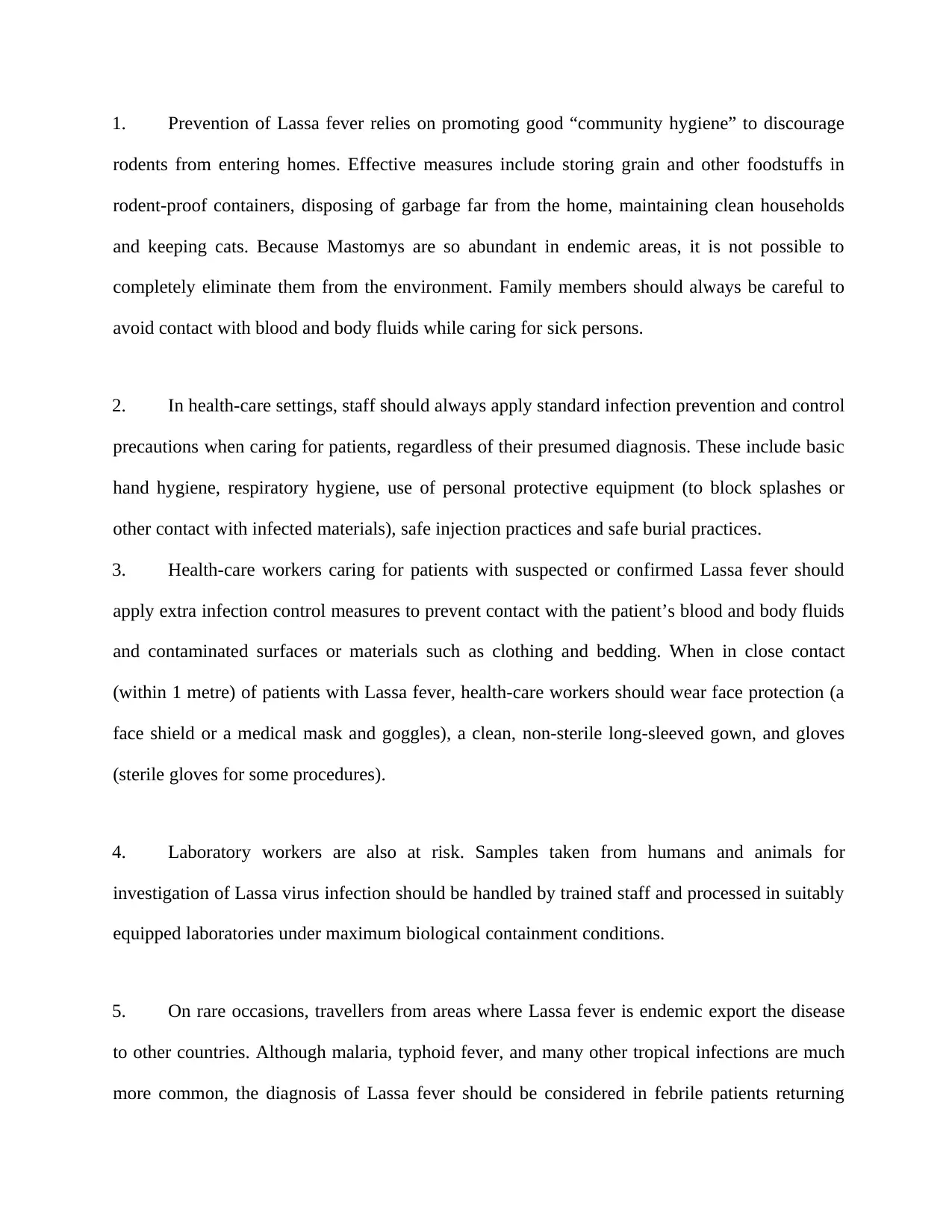
1. Prevention of Lassa fever relies on promoting good “community hygiene” to discourage
rodents from entering homes. Effective measures include storing grain and other foodstuffs in
rodent-proof containers, disposing of garbage far from the home, maintaining clean households
and keeping cats. Because Mastomys are so abundant in endemic areas, it is not possible to
completely eliminate them from the environment. Family members should always be careful to
avoid contact with blood and body fluids while caring for sick persons.
2. In health-care settings, staff should always apply standard infection prevention and control
precautions when caring for patients, regardless of their presumed diagnosis. These include basic
hand hygiene, respiratory hygiene, use of personal protective equipment (to block splashes or
other contact with infected materials), safe injection practices and safe burial practices.
3. Health-care workers caring for patients with suspected or confirmed Lassa fever should
apply extra infection control measures to prevent contact with the patient’s blood and body fluids
and contaminated surfaces or materials such as clothing and bedding. When in close contact
(within 1 metre) of patients with Lassa fever, health-care workers should wear face protection (a
face shield or a medical mask and goggles), a clean, non-sterile long-sleeved gown, and gloves
(sterile gloves for some procedures).
4. Laboratory workers are also at risk. Samples taken from humans and animals for
investigation of Lassa virus infection should be handled by trained staff and processed in suitably
equipped laboratories under maximum biological containment conditions.
5. On rare occasions, travellers from areas where Lassa fever is endemic export the disease
to other countries. Although malaria, typhoid fever, and many other tropical infections are much
more common, the diagnosis of Lassa fever should be considered in febrile patients returning
rodents from entering homes. Effective measures include storing grain and other foodstuffs in
rodent-proof containers, disposing of garbage far from the home, maintaining clean households
and keeping cats. Because Mastomys are so abundant in endemic areas, it is not possible to
completely eliminate them from the environment. Family members should always be careful to
avoid contact with blood and body fluids while caring for sick persons.
2. In health-care settings, staff should always apply standard infection prevention and control
precautions when caring for patients, regardless of their presumed diagnosis. These include basic
hand hygiene, respiratory hygiene, use of personal protective equipment (to block splashes or
other contact with infected materials), safe injection practices and safe burial practices.
3. Health-care workers caring for patients with suspected or confirmed Lassa fever should
apply extra infection control measures to prevent contact with the patient’s blood and body fluids
and contaminated surfaces or materials such as clothing and bedding. When in close contact
(within 1 metre) of patients with Lassa fever, health-care workers should wear face protection (a
face shield or a medical mask and goggles), a clean, non-sterile long-sleeved gown, and gloves
(sterile gloves for some procedures).
4. Laboratory workers are also at risk. Samples taken from humans and animals for
investigation of Lassa virus infection should be handled by trained staff and processed in suitably
equipped laboratories under maximum biological containment conditions.
5. On rare occasions, travellers from areas where Lassa fever is endemic export the disease
to other countries. Although malaria, typhoid fever, and many other tropical infections are much
more common, the diagnosis of Lassa fever should be considered in febrile patients returning
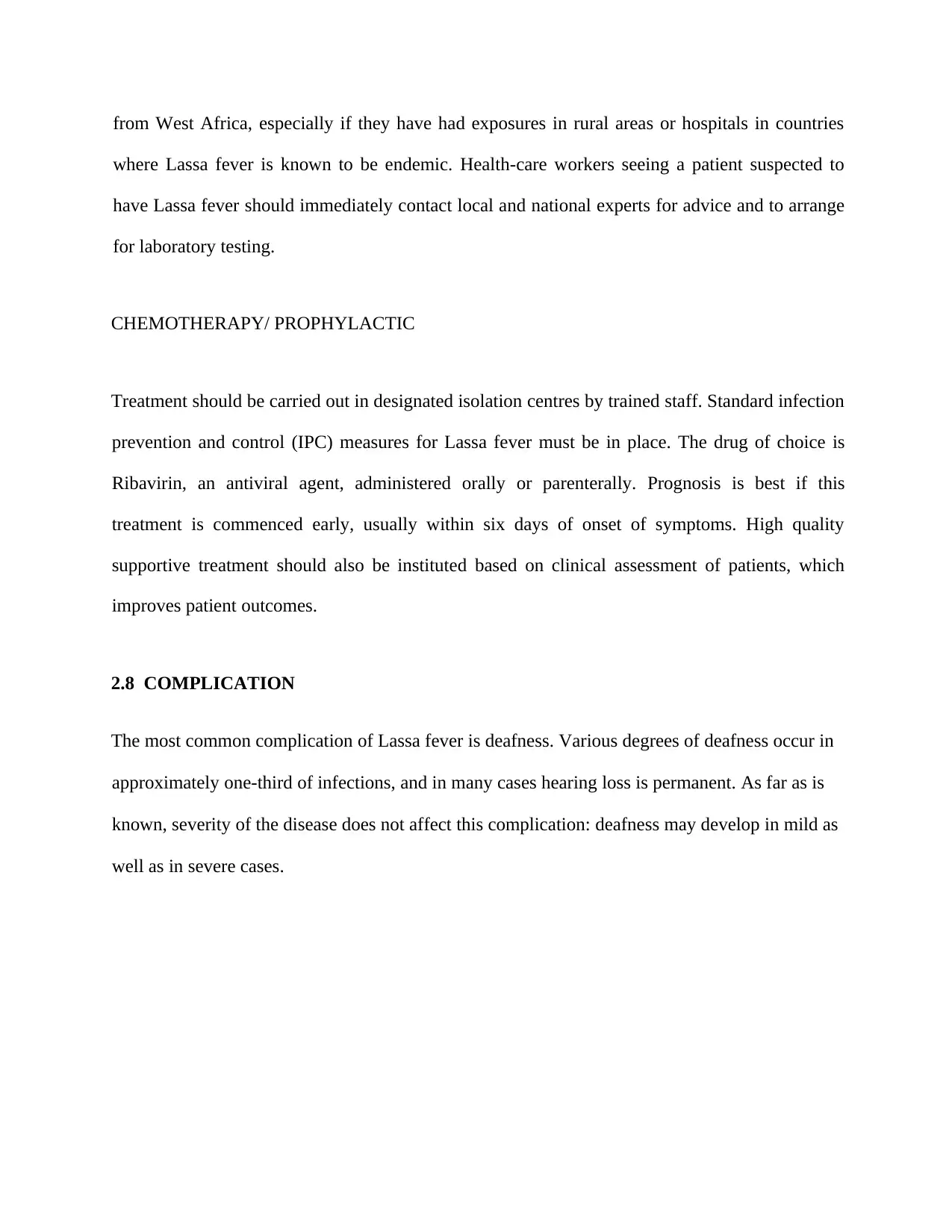
from West Africa, especially if they have had exposures in rural areas or hospitals in countries
where Lassa fever is known to be endemic. Health-care workers seeing a patient suspected to
have Lassa fever should immediately contact local and national experts for advice and to arrange
for laboratory testing.
CHEMOTHERAPY/ PROPHYLACTIC
Treatment should be carried out in designated isolation centres by trained staff. Standard infection
prevention and control (IPC) measures for Lassa fever must be in place. The drug of choice is
Ribavirin, an antiviral agent, administered orally or parenterally. Prognosis is best if this
treatment is commenced early, usually within six days of onset of symptoms. High quality
supportive treatment should also be instituted based on clinical assessment of patients, which
improves patient outcomes.
2.8 COMPLICATION
The most common complication of Lassa fever is deafness. Various degrees of deafness occur in
approximately one-third of infections, and in many cases hearing loss is permanent. As far as is
known, severity of the disease does not affect this complication: deafness may develop in mild as
well as in severe cases.
where Lassa fever is known to be endemic. Health-care workers seeing a patient suspected to
have Lassa fever should immediately contact local and national experts for advice and to arrange
for laboratory testing.
CHEMOTHERAPY/ PROPHYLACTIC
Treatment should be carried out in designated isolation centres by trained staff. Standard infection
prevention and control (IPC) measures for Lassa fever must be in place. The drug of choice is
Ribavirin, an antiviral agent, administered orally or parenterally. Prognosis is best if this
treatment is commenced early, usually within six days of onset of symptoms. High quality
supportive treatment should also be instituted based on clinical assessment of patients, which
improves patient outcomes.
2.8 COMPLICATION
The most common complication of Lassa fever is deafness. Various degrees of deafness occur in
approximately one-third of infections, and in many cases hearing loss is permanent. As far as is
known, severity of the disease does not affect this complication: deafness may develop in mild as
well as in severe cases.
Paraphrase This Document
Need a fresh take? Get an instant paraphrase of this document with our AI Paraphraser
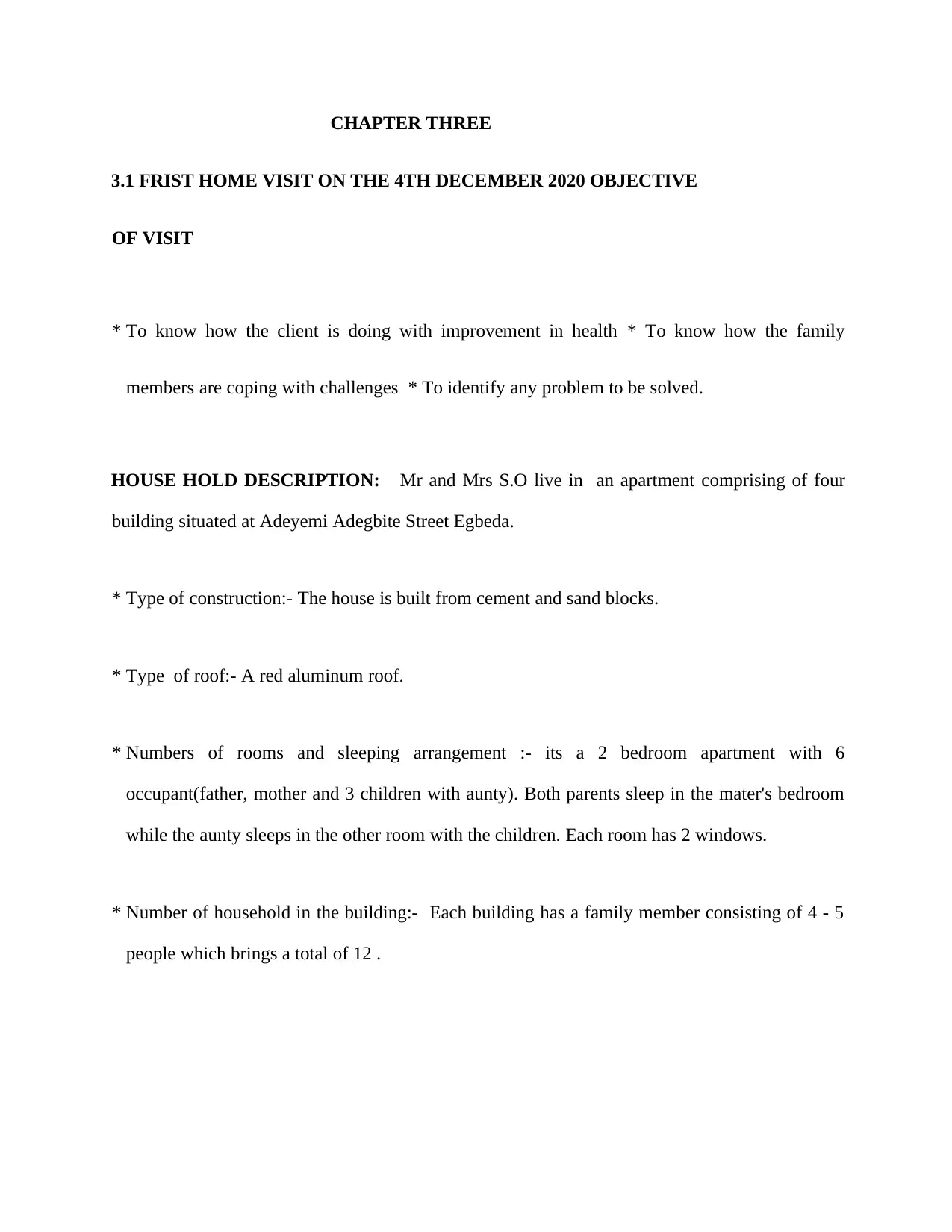
CHAPTER THREE
3.1 FRIST HOME VISIT ON THE 4TH DECEMBER 2020 OBJECTIVE
OF VISIT
* To know how the client is doing with improvement in health * To know how the family
members are coping with challenges * To identify any problem to be solved.
HOUSE HOLD DESCRIPTION: Mr and Mrs S.O live in an apartment comprising of four
building situated at Adeyemi Adegbite Street Egbeda.
* Type of construction:- The house is built from cement and sand blocks.
* Type of roof:- A red aluminum roof.
* Numbers of rooms and sleeping arrangement :- its a 2 bedroom apartment with 6
occupant(father, mother and 3 children with aunty). Both parents sleep in the mater's bedroom
while the aunty sleeps in the other room with the children. Each room has 2 windows.
* Number of household in the building:- Each building has a family member consisting of 4 - 5
people which brings a total of 12 .
3.1 FRIST HOME VISIT ON THE 4TH DECEMBER 2020 OBJECTIVE
OF VISIT
* To know how the client is doing with improvement in health * To know how the family
members are coping with challenges * To identify any problem to be solved.
HOUSE HOLD DESCRIPTION: Mr and Mrs S.O live in an apartment comprising of four
building situated at Adeyemi Adegbite Street Egbeda.
* Type of construction:- The house is built from cement and sand blocks.
* Type of roof:- A red aluminum roof.
* Numbers of rooms and sleeping arrangement :- its a 2 bedroom apartment with 6
occupant(father, mother and 3 children with aunty). Both parents sleep in the mater's bedroom
while the aunty sleeps in the other room with the children. Each room has 2 windows.
* Number of household in the building:- Each building has a family member consisting of 4 - 5
people which brings a total of 12 .
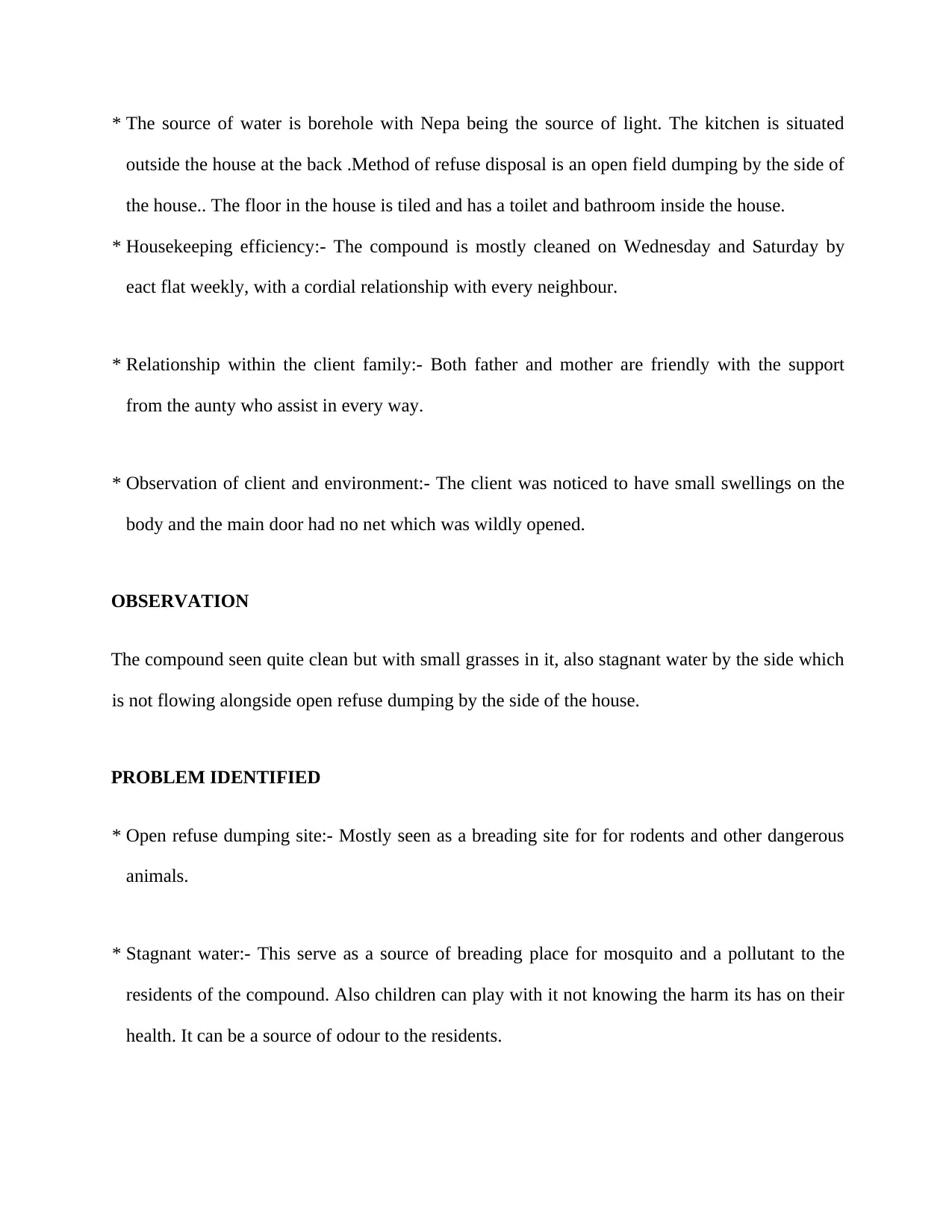
* The source of water is borehole with Nepa being the source of light. The kitchen is situated
outside the house at the back .Method of refuse disposal is an open field dumping by the side of
the house.. The floor in the house is tiled and has a toilet and bathroom inside the house.
* Housekeeping efficiency:- The compound is mostly cleaned on Wednesday and Saturday by
eact flat weekly, with a cordial relationship with every neighbour.
* Relationship within the client family:- Both father and mother are friendly with the support
from the aunty who assist in every way.
* Observation of client and environment:- The client was noticed to have small swellings on the
body and the main door had no net which was wildly opened.
OBSERVATION
The compound seen quite clean but with small grasses in it, also stagnant water by the side which
is not flowing alongside open refuse dumping by the side of the house.
PROBLEM IDENTIFIED
* Open refuse dumping site:- Mostly seen as a breading site for for rodents and other dangerous
animals.
* Stagnant water:- This serve as a source of breading place for mosquito and a pollutant to the
residents of the compound. Also children can play with it not knowing the harm its has on their
health. It can be a source of odour to the residents.
outside the house at the back .Method of refuse disposal is an open field dumping by the side of
the house.. The floor in the house is tiled and has a toilet and bathroom inside the house.
* Housekeeping efficiency:- The compound is mostly cleaned on Wednesday and Saturday by
eact flat weekly, with a cordial relationship with every neighbour.
* Relationship within the client family:- Both father and mother are friendly with the support
from the aunty who assist in every way.
* Observation of client and environment:- The client was noticed to have small swellings on the
body and the main door had no net which was wildly opened.
OBSERVATION
The compound seen quite clean but with small grasses in it, also stagnant water by the side which
is not flowing alongside open refuse dumping by the side of the house.
PROBLEM IDENTIFIED
* Open refuse dumping site:- Mostly seen as a breading site for for rodents and other dangerous
animals.
* Stagnant water:- This serve as a source of breading place for mosquito and a pollutant to the
residents of the compound. Also children can play with it not knowing the harm its has on their
health. It can be a source of odour to the residents.
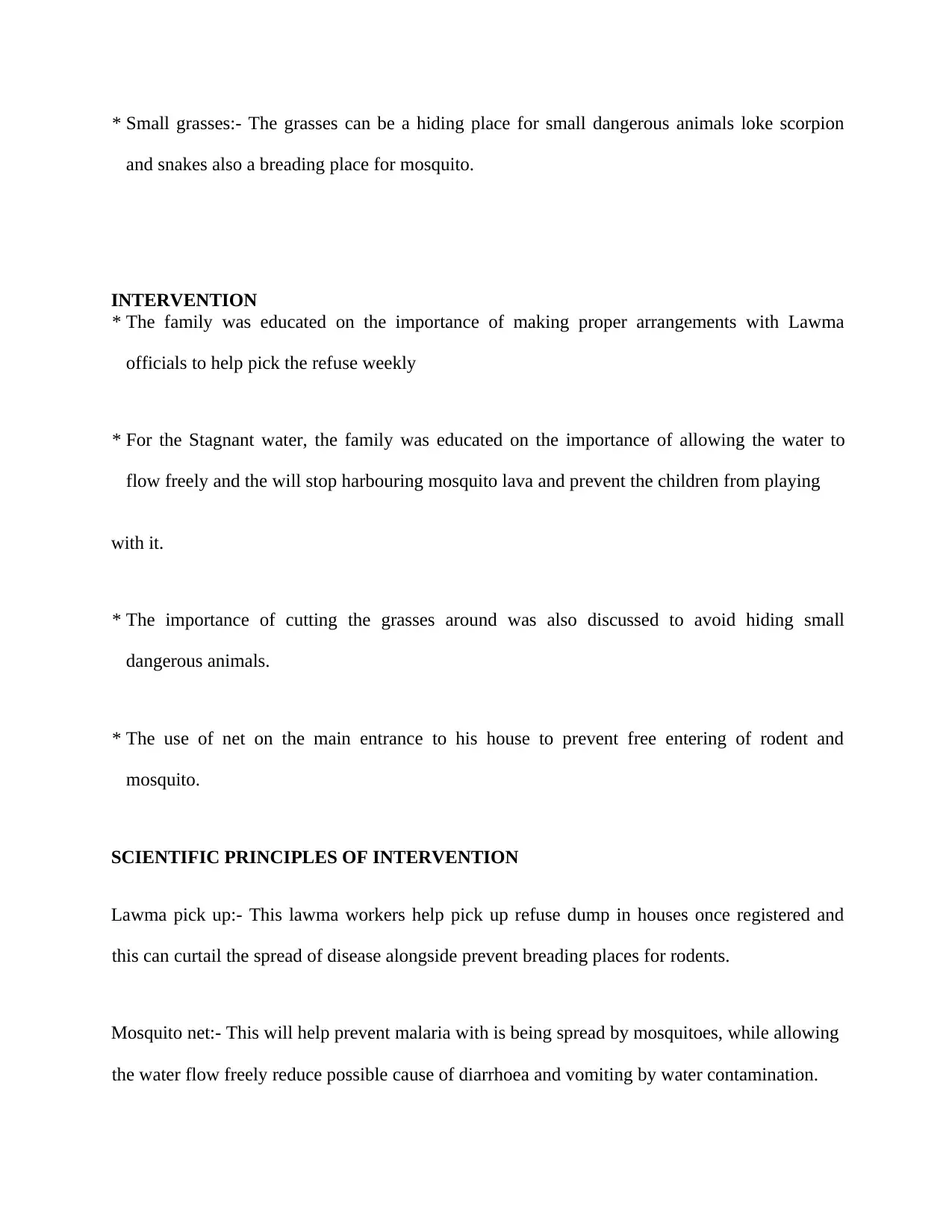
* Small grasses:- The grasses can be a hiding place for small dangerous animals loke scorpion
and snakes also a breading place for mosquito.
INTERVENTION
* The family was educated on the importance of making proper arrangements with Lawma
officials to help pick the refuse weekly
* For the Stagnant water, the family was educated on the importance of allowing the water to
flow freely and the will stop harbouring mosquito lava and prevent the children from playing
with it.
* The importance of cutting the grasses around was also discussed to avoid hiding small
dangerous animals.
* The use of net on the main entrance to his house to prevent free entering of rodent and
mosquito.
SCIENTIFIC PRINCIPLES OF INTERVENTION
Lawma pick up:- This lawma workers help pick up refuse dump in houses once registered and
this can curtail the spread of disease alongside prevent breading places for rodents.
Mosquito net:- This will help prevent malaria with is being spread by mosquitoes, while allowing
the water flow freely reduce possible cause of diarrhoea and vomiting by water contamination.
and snakes also a breading place for mosquito.
INTERVENTION
* The family was educated on the importance of making proper arrangements with Lawma
officials to help pick the refuse weekly
* For the Stagnant water, the family was educated on the importance of allowing the water to
flow freely and the will stop harbouring mosquito lava and prevent the children from playing
with it.
* The importance of cutting the grasses around was also discussed to avoid hiding small
dangerous animals.
* The use of net on the main entrance to his house to prevent free entering of rodent and
mosquito.
SCIENTIFIC PRINCIPLES OF INTERVENTION
Lawma pick up:- This lawma workers help pick up refuse dump in houses once registered and
this can curtail the spread of disease alongside prevent breading places for rodents.
Mosquito net:- This will help prevent malaria with is being spread by mosquitoes, while allowing
the water flow freely reduce possible cause of diarrhoea and vomiting by water contamination.
Secure Best Marks with AI Grader
Need help grading? Try our AI Grader for instant feedback on your assignments.
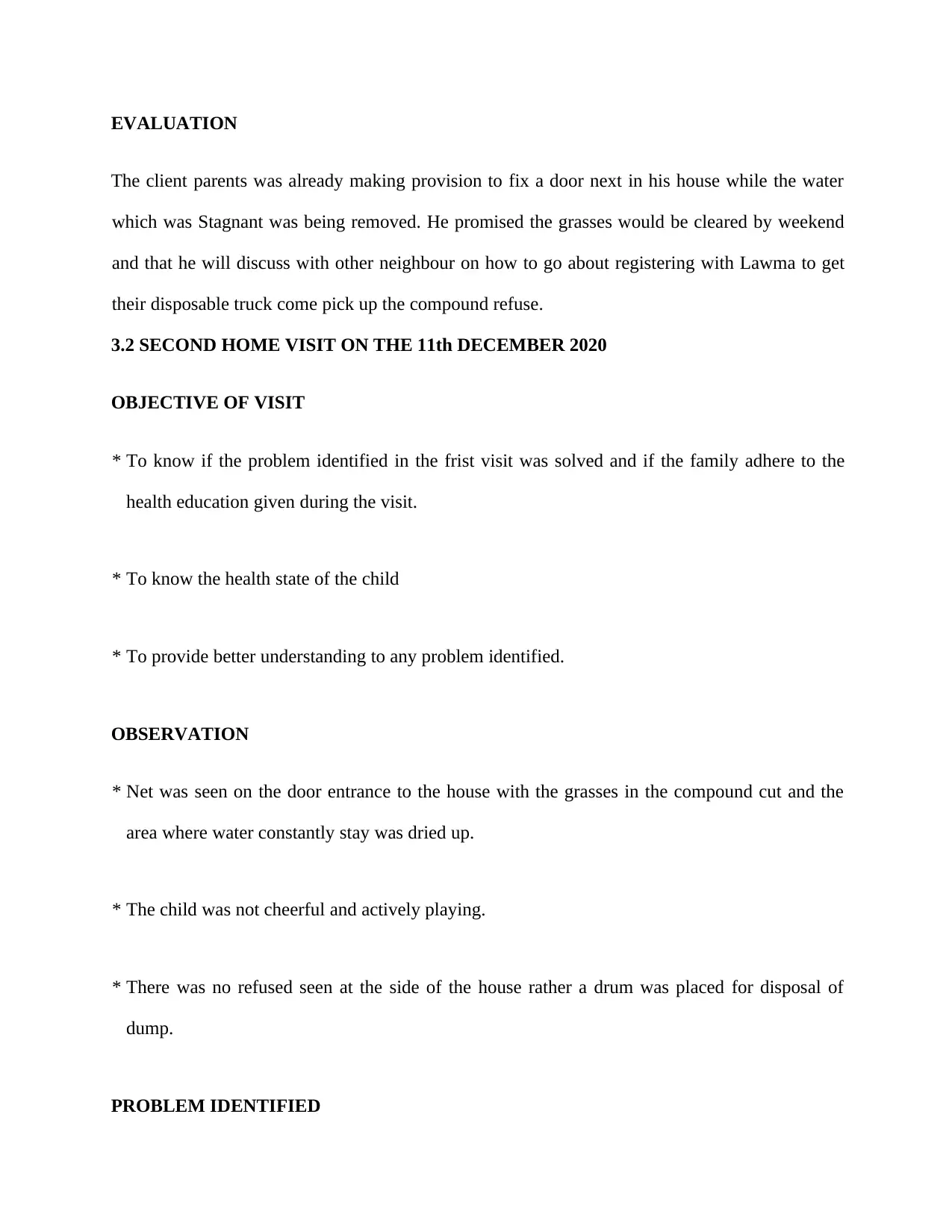
EVALUATION
The client parents was already making provision to fix a door next in his house while the water
which was Stagnant was being removed. He promised the grasses would be cleared by weekend
and that he will discuss with other neighbour on how to go about registering with Lawma to get
their disposable truck come pick up the compound refuse.
3.2 SECOND HOME VISIT ON THE 11th DECEMBER 2020
OBJECTIVE OF VISIT
* To know if the problem identified in the frist visit was solved and if the family adhere to the
health education given during the visit.
* To know the health state of the child
* To provide better understanding to any problem identified.
OBSERVATION
* Net was seen on the door entrance to the house with the grasses in the compound cut and the
area where water constantly stay was dried up.
* The child was not cheerful and actively playing.
* There was no refused seen at the side of the house rather a drum was placed for disposal of
dump.
PROBLEM IDENTIFIED
The client parents was already making provision to fix a door next in his house while the water
which was Stagnant was being removed. He promised the grasses would be cleared by weekend
and that he will discuss with other neighbour on how to go about registering with Lawma to get
their disposable truck come pick up the compound refuse.
3.2 SECOND HOME VISIT ON THE 11th DECEMBER 2020
OBJECTIVE OF VISIT
* To know if the problem identified in the frist visit was solved and if the family adhere to the
health education given during the visit.
* To know the health state of the child
* To provide better understanding to any problem identified.
OBSERVATION
* Net was seen on the door entrance to the house with the grasses in the compound cut and the
area where water constantly stay was dried up.
* The child was not cheerful and actively playing.
* There was no refused seen at the side of the house rather a drum was placed for disposal of
dump.
PROBLEM IDENTIFIED
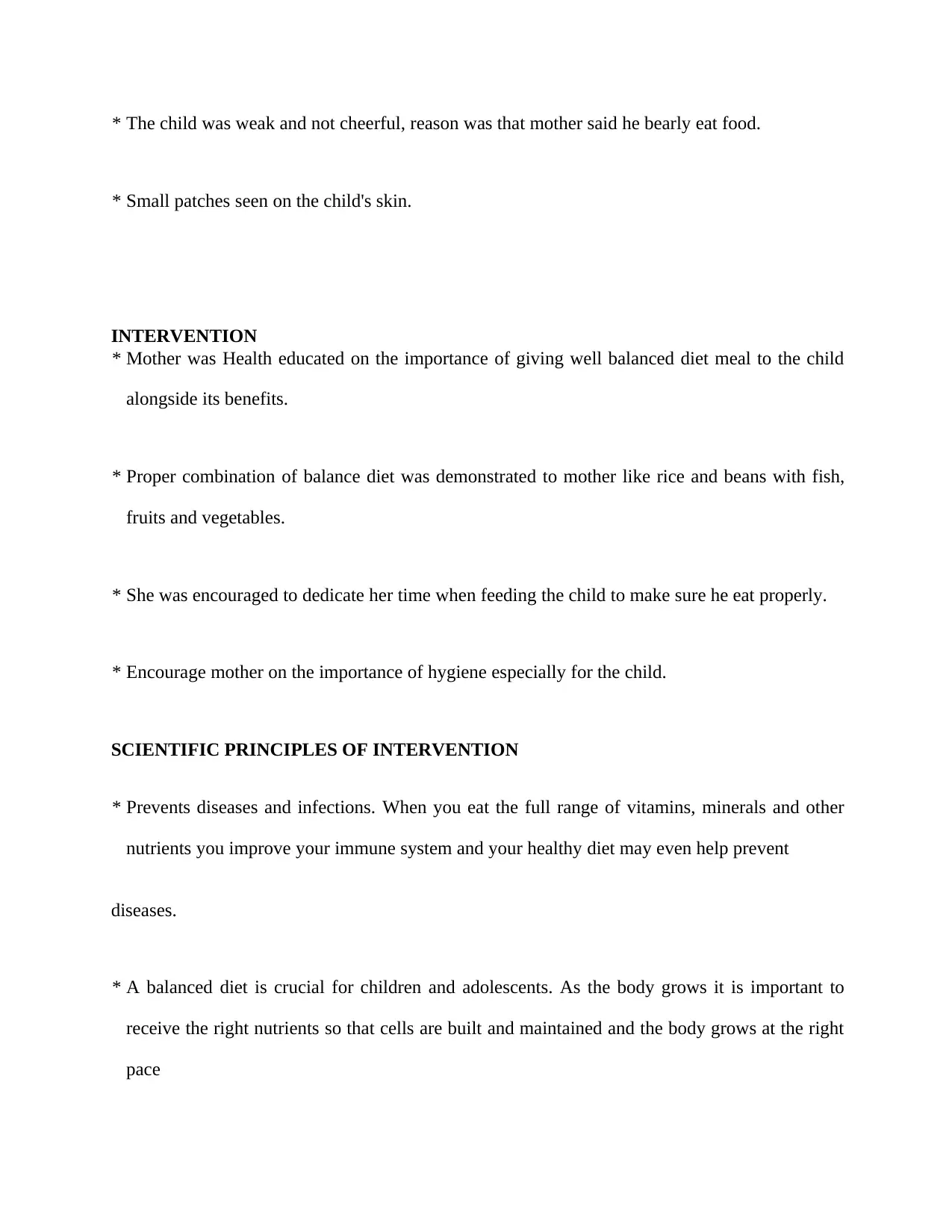
* The child was weak and not cheerful, reason was that mother said he bearly eat food.
* Small patches seen on the child's skin.
INTERVENTION
* Mother was Health educated on the importance of giving well balanced diet meal to the child
alongside its benefits.
* Proper combination of balance diet was demonstrated to mother like rice and beans with fish,
fruits and vegetables.
* She was encouraged to dedicate her time when feeding the child to make sure he eat properly.
* Encourage mother on the importance of hygiene especially for the child.
SCIENTIFIC PRINCIPLES OF INTERVENTION
* Prevents diseases and infections. When you eat the full range of vitamins, minerals and other
nutrients you improve your immune system and your healthy diet may even help prevent
diseases.
* A balanced diet is crucial for children and adolescents. As the body grows it is important to
receive the right nutrients so that cells are built and maintained and the body grows at the right
pace
* Small patches seen on the child's skin.
INTERVENTION
* Mother was Health educated on the importance of giving well balanced diet meal to the child
alongside its benefits.
* Proper combination of balance diet was demonstrated to mother like rice and beans with fish,
fruits and vegetables.
* She was encouraged to dedicate her time when feeding the child to make sure he eat properly.
* Encourage mother on the importance of hygiene especially for the child.
SCIENTIFIC PRINCIPLES OF INTERVENTION
* Prevents diseases and infections. When you eat the full range of vitamins, minerals and other
nutrients you improve your immune system and your healthy diet may even help prevent
diseases.
* A balanced diet is crucial for children and adolescents. As the body grows it is important to
receive the right nutrients so that cells are built and maintained and the body grows at the right
pace
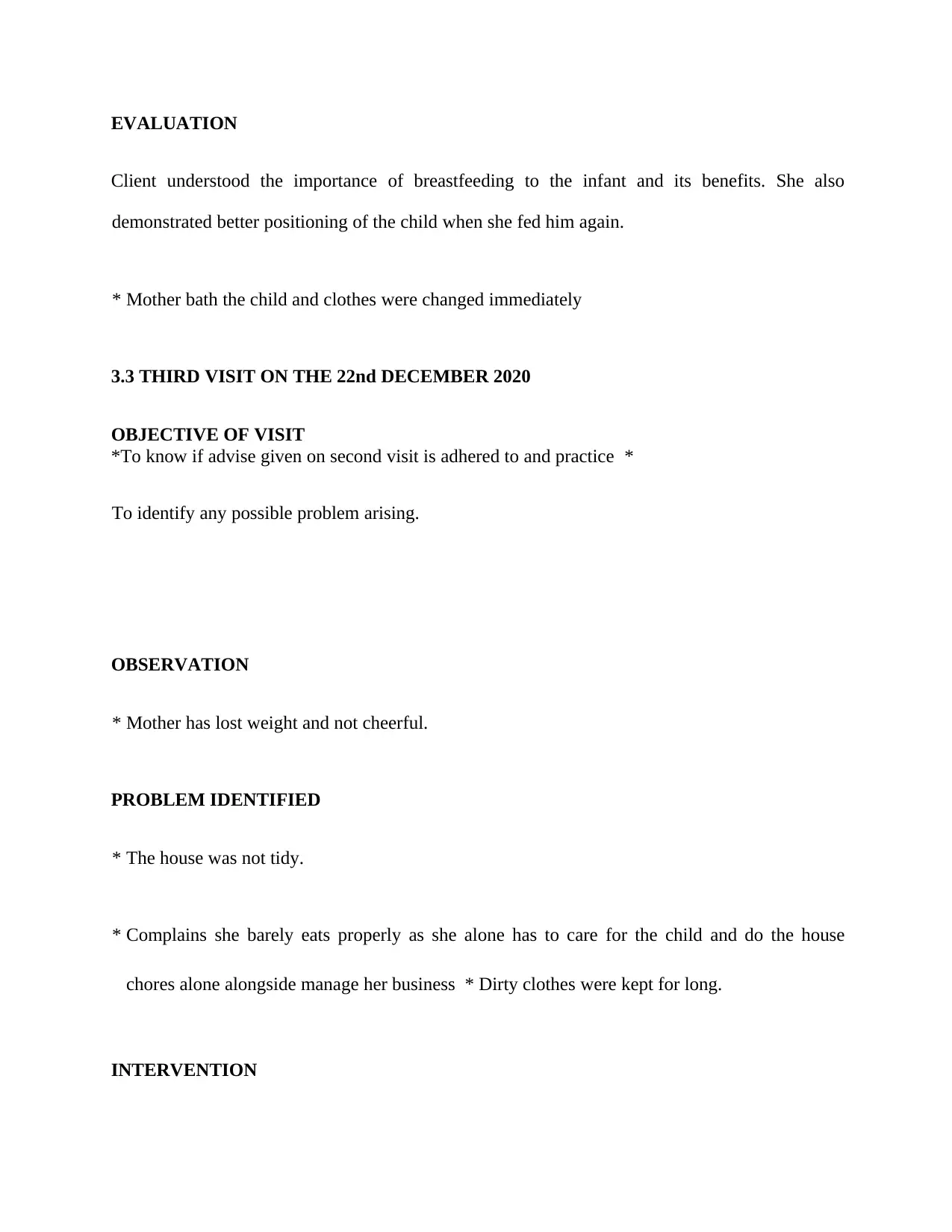
EVALUATION
Client understood the importance of breastfeeding to the infant and its benefits. She also
demonstrated better positioning of the child when she fed him again.
* Mother bath the child and clothes were changed immediately
3.3 THIRD VISIT ON THE 22nd DECEMBER 2020
OBJECTIVE OF VISIT
*To know if advise given on second visit is adhered to and practice *
To identify any possible problem arising.
OBSERVATION
* Mother has lost weight and not cheerful.
PROBLEM IDENTIFIED
* The house was not tidy.
* Complains she barely eats properly as she alone has to care for the child and do the house
chores alone alongside manage her business * Dirty clothes were kept for long.
INTERVENTION
Client understood the importance of breastfeeding to the infant and its benefits. She also
demonstrated better positioning of the child when she fed him again.
* Mother bath the child and clothes were changed immediately
3.3 THIRD VISIT ON THE 22nd DECEMBER 2020
OBJECTIVE OF VISIT
*To know if advise given on second visit is adhered to and practice *
To identify any possible problem arising.
OBSERVATION
* Mother has lost weight and not cheerful.
PROBLEM IDENTIFIED
* The house was not tidy.
* Complains she barely eats properly as she alone has to care for the child and do the house
chores alone alongside manage her business * Dirty clothes were kept for long.
INTERVENTION
Paraphrase This Document
Need a fresh take? Get an instant paraphrase of this document with our AI Paraphraser
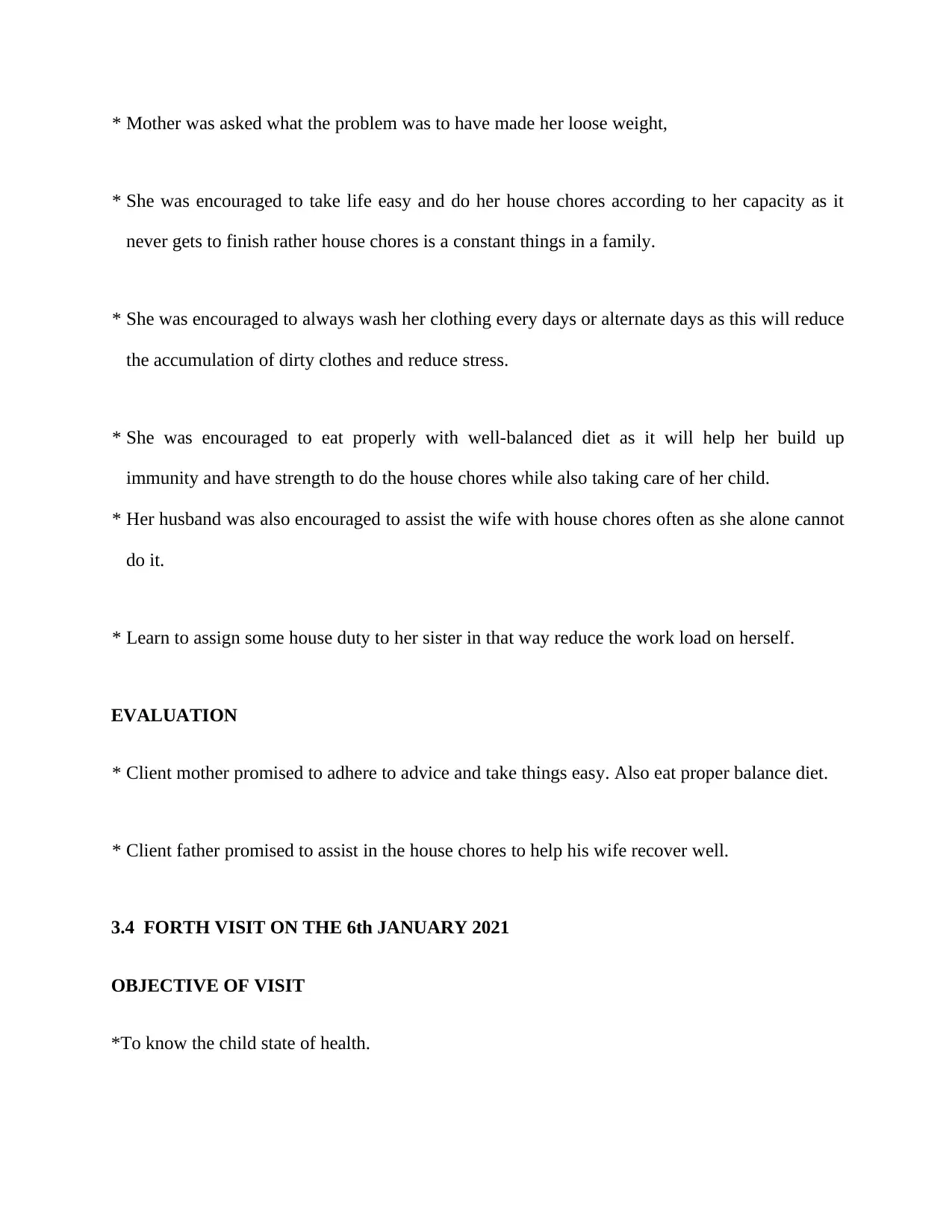
* Mother was asked what the problem was to have made her loose weight,
* She was encouraged to take life easy and do her house chores according to her capacity as it
never gets to finish rather house chores is a constant things in a family.
* She was encouraged to always wash her clothing every days or alternate days as this will reduce
the accumulation of dirty clothes and reduce stress.
* She was encouraged to eat properly with well-balanced diet as it will help her build up
immunity and have strength to do the house chores while also taking care of her child.
* Her husband was also encouraged to assist the wife with house chores often as she alone cannot
do it.
* Learn to assign some house duty to her sister in that way reduce the work load on herself.
EVALUATION
* Client mother promised to adhere to advice and take things easy. Also eat proper balance diet.
* Client father promised to assist in the house chores to help his wife recover well.
3.4 FORTH VISIT ON THE 6th JANUARY 2021
OBJECTIVE OF VISIT
*To know the child state of health.
* She was encouraged to take life easy and do her house chores according to her capacity as it
never gets to finish rather house chores is a constant things in a family.
* She was encouraged to always wash her clothing every days or alternate days as this will reduce
the accumulation of dirty clothes and reduce stress.
* She was encouraged to eat properly with well-balanced diet as it will help her build up
immunity and have strength to do the house chores while also taking care of her child.
* Her husband was also encouraged to assist the wife with house chores often as she alone cannot
do it.
* Learn to assign some house duty to her sister in that way reduce the work load on herself.
EVALUATION
* Client mother promised to adhere to advice and take things easy. Also eat proper balance diet.
* Client father promised to assist in the house chores to help his wife recover well.
3.4 FORTH VISIT ON THE 6th JANUARY 2021
OBJECTIVE OF VISIT
*To know the child state of health.
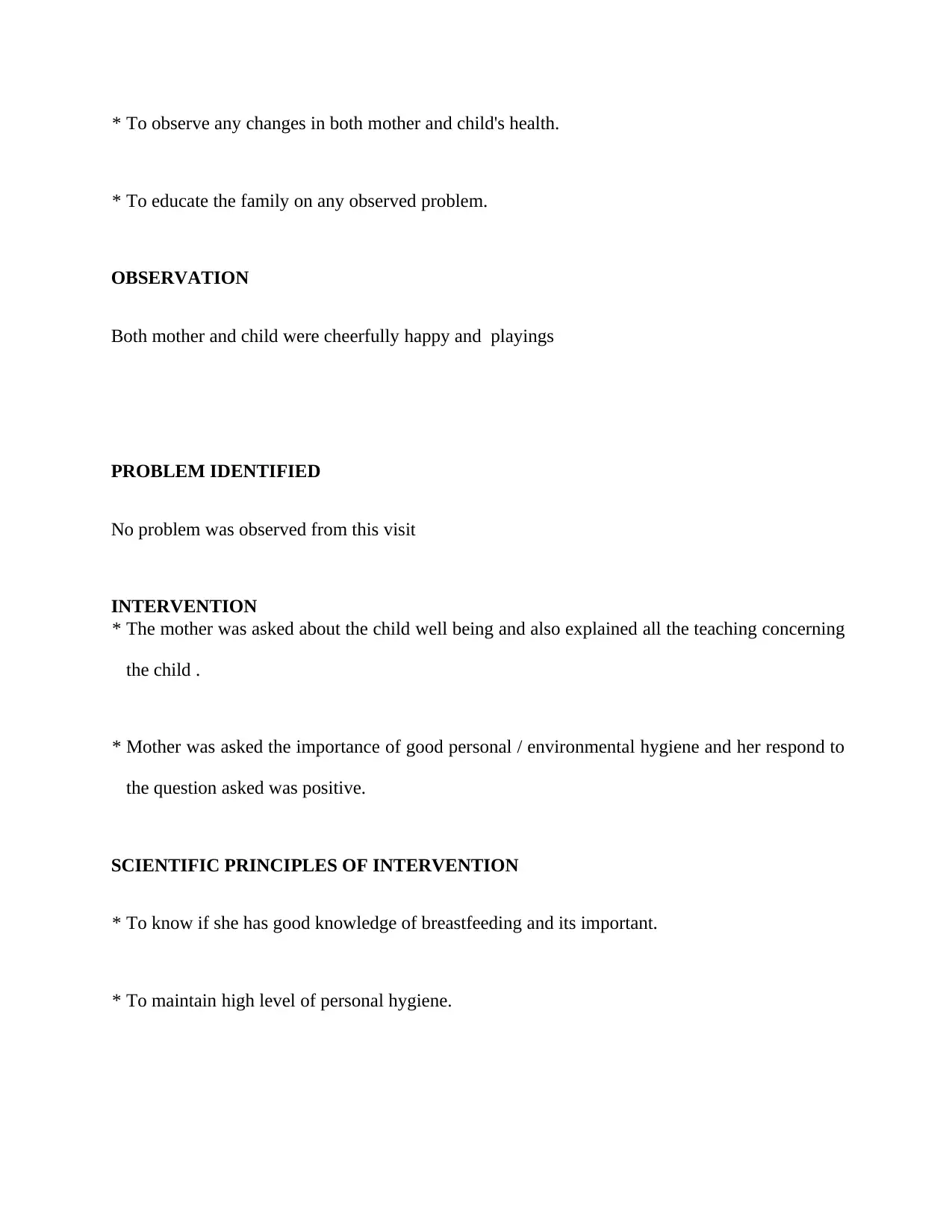
* To observe any changes in both mother and child's health.
* To educate the family on any observed problem.
OBSERVATION
Both mother and child were cheerfully happy and playings
PROBLEM IDENTIFIED
No problem was observed from this visit
INTERVENTION
* The mother was asked about the child well being and also explained all the teaching concerning
the child .
* Mother was asked the importance of good personal / environmental hygiene and her respond to
the question asked was positive.
SCIENTIFIC PRINCIPLES OF INTERVENTION
* To know if she has good knowledge of breastfeeding and its important.
* To maintain high level of personal hygiene.
* To educate the family on any observed problem.
OBSERVATION
Both mother and child were cheerfully happy and playings
PROBLEM IDENTIFIED
No problem was observed from this visit
INTERVENTION
* The mother was asked about the child well being and also explained all the teaching concerning
the child .
* Mother was asked the importance of good personal / environmental hygiene and her respond to
the question asked was positive.
SCIENTIFIC PRINCIPLES OF INTERVENTION
* To know if she has good knowledge of breastfeeding and its important.
* To maintain high level of personal hygiene.
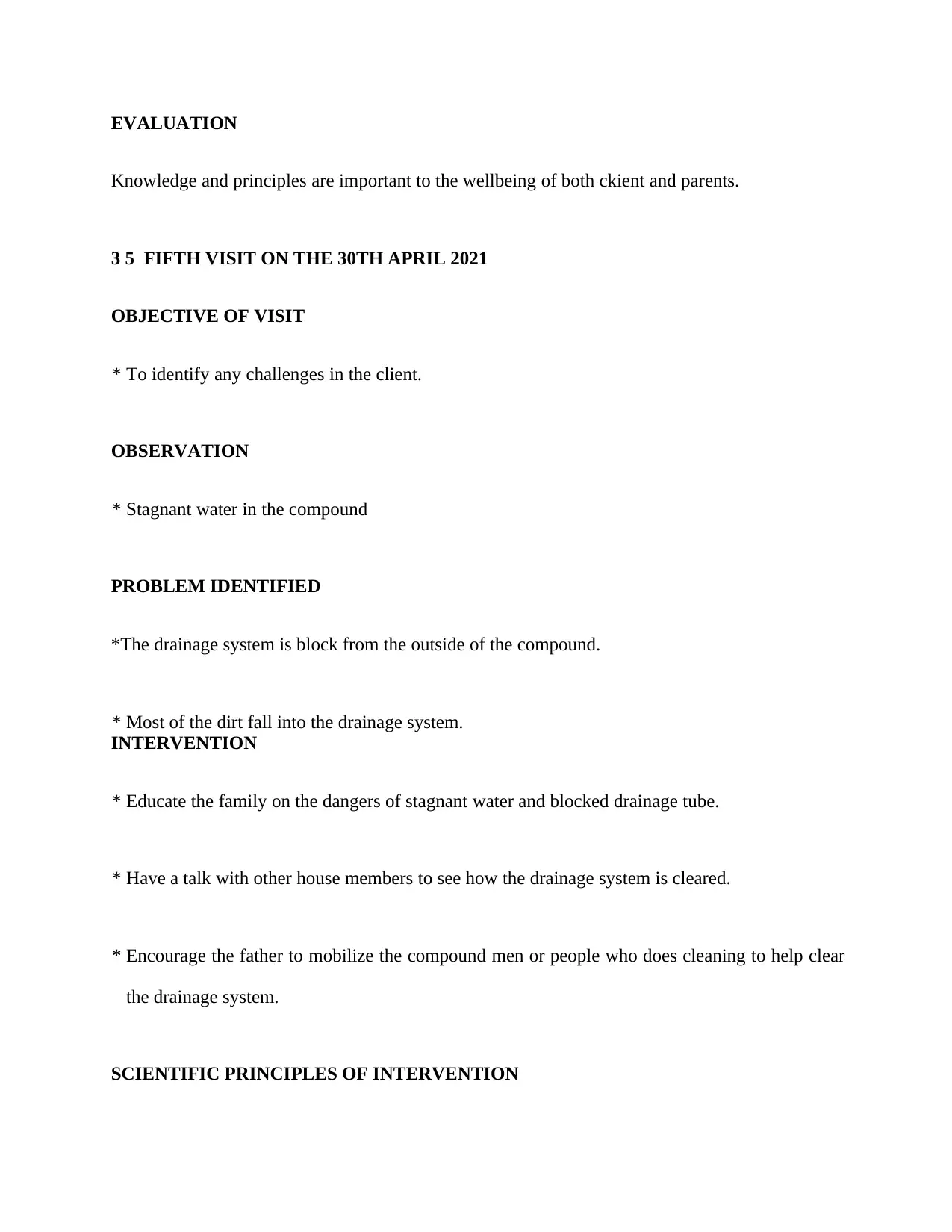
EVALUATION
Knowledge and principles are important to the wellbeing of both ckient and parents.
3 5 FIFTH VISIT ON THE 30TH APRIL 2021
OBJECTIVE OF VISIT
* To identify any challenges in the client.
OBSERVATION
* Stagnant water in the compound
PROBLEM IDENTIFIED
*The drainage system is block from the outside of the compound.
* Most of the dirt fall into the drainage system.
INTERVENTION
* Educate the family on the dangers of stagnant water and blocked drainage tube.
* Have a talk with other house members to see how the drainage system is cleared.
* Encourage the father to mobilize the compound men or people who does cleaning to help clear
the drainage system.
SCIENTIFIC PRINCIPLES OF INTERVENTION
Knowledge and principles are important to the wellbeing of both ckient and parents.
3 5 FIFTH VISIT ON THE 30TH APRIL 2021
OBJECTIVE OF VISIT
* To identify any challenges in the client.
OBSERVATION
* Stagnant water in the compound
PROBLEM IDENTIFIED
*The drainage system is block from the outside of the compound.
* Most of the dirt fall into the drainage system.
INTERVENTION
* Educate the family on the dangers of stagnant water and blocked drainage tube.
* Have a talk with other house members to see how the drainage system is cleared.
* Encourage the father to mobilize the compound men or people who does cleaning to help clear
the drainage system.
SCIENTIFIC PRINCIPLES OF INTERVENTION
Secure Best Marks with AI Grader
Need help grading? Try our AI Grader for instant feedback on your assignments.
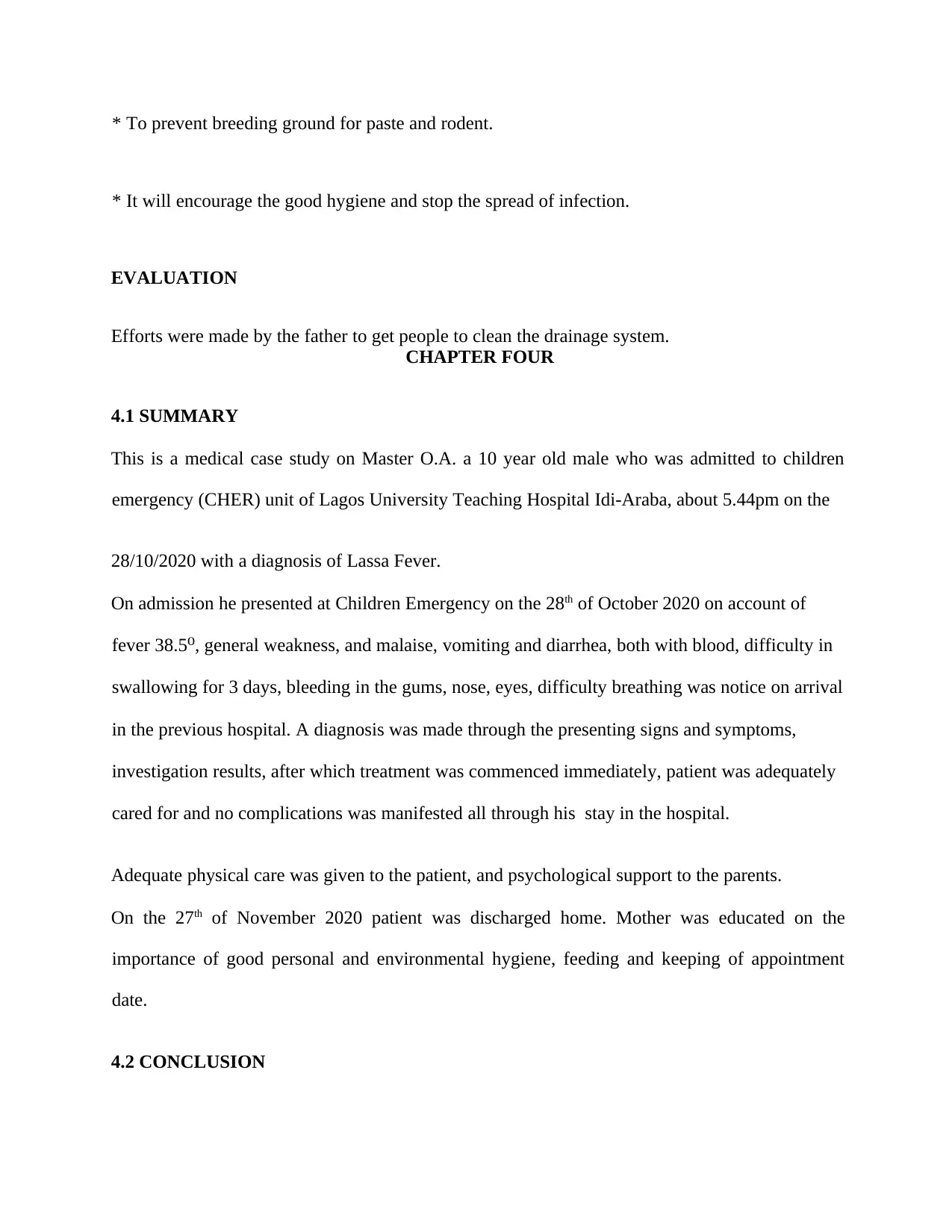
* To prevent breeding ground for paste and rodent.
* It will encourage the good hygiene and stop the spread of infection.
EVALUATION
Efforts were made by the father to get people to clean the drainage system.
CHAPTER FOUR
4.1 SUMMARY
This is a medical case study on Master O.A. a 10 year old male who was admitted to children
emergency (CHER) unit of Lagos University Teaching Hospital Idi-Araba, about 5.44pm on the
28/10/2020 with a diagnosis of Lassa Fever.
On admission he presented at Children Emergency on the 28th of October 2020 on account of
fever 38.5 , general weakness, and malaise, vomiting and diarrhea, both with blood, difficulty in⁰
swallowing for 3 days, bleeding in the gums, nose, eyes, difficulty breathing was notice on arrival
in the previous hospital. A diagnosis was made through the presenting signs and symptoms,
investigation results, after which treatment was commenced immediately, patient was adequately
cared for and no complications was manifested all through his stay in the hospital.
Adequate physical care was given to the patient, and psychological support to the parents.
On the 27th of November 2020 patient was discharged home. Mother was educated on the
importance of good personal and environmental hygiene, feeding and keeping of appointment
date.
4.2 CONCLUSION
* It will encourage the good hygiene and stop the spread of infection.
EVALUATION
Efforts were made by the father to get people to clean the drainage system.
CHAPTER FOUR
4.1 SUMMARY
This is a medical case study on Master O.A. a 10 year old male who was admitted to children
emergency (CHER) unit of Lagos University Teaching Hospital Idi-Araba, about 5.44pm on the
28/10/2020 with a diagnosis of Lassa Fever.
On admission he presented at Children Emergency on the 28th of October 2020 on account of
fever 38.5 , general weakness, and malaise, vomiting and diarrhea, both with blood, difficulty in⁰
swallowing for 3 days, bleeding in the gums, nose, eyes, difficulty breathing was notice on arrival
in the previous hospital. A diagnosis was made through the presenting signs and symptoms,
investigation results, after which treatment was commenced immediately, patient was adequately
cared for and no complications was manifested all through his stay in the hospital.
Adequate physical care was given to the patient, and psychological support to the parents.
On the 27th of November 2020 patient was discharged home. Mother was educated on the
importance of good personal and environmental hygiene, feeding and keeping of appointment
date.
4.2 CONCLUSION
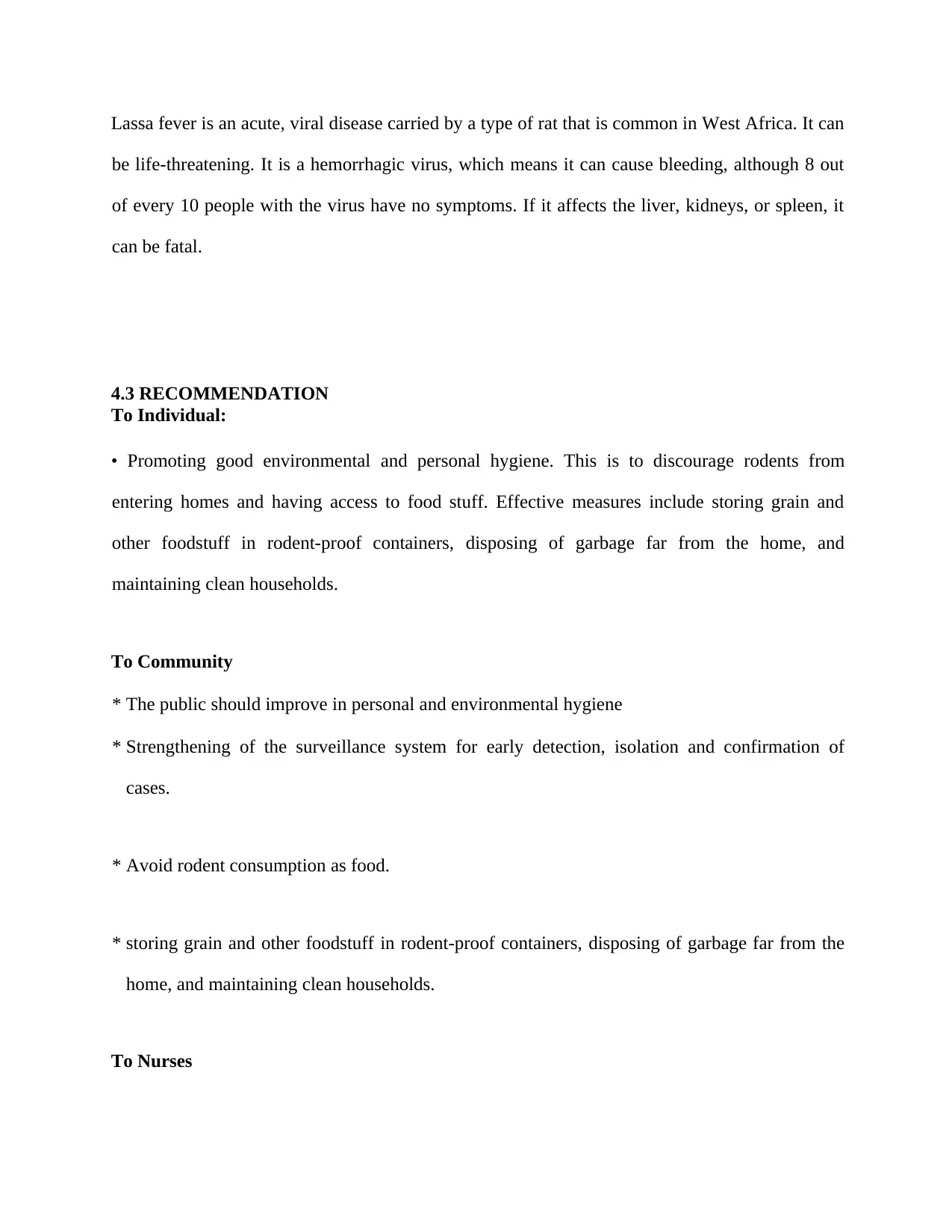
Lassa fever is an acute, viral disease carried by a type of rat that is common in West Africa. It can
be life-threatening. It is a hemorrhagic virus, which means it can cause bleeding, although 8 out
of every 10 people with the virus have no symptoms. If it affects the liver, kidneys, or spleen, it
can be fatal.
4.3 RECOMMENDATION
To Individual:
• Promoting good environmental and personal hygiene. This is to discourage rodents from
entering homes and having access to food stuff. Effective measures include storing grain and
other foodstuff in rodent-proof containers, disposing of garbage far from the home, and
maintaining clean households.
To Community
* The public should improve in personal and environmental hygiene
* Strengthening of the surveillance system for early detection, isolation and confirmation of
cases.
* Avoid rodent consumption as food.
* storing grain and other foodstuff in rodent-proof containers, disposing of garbage far from the
home, and maintaining clean households.
To Nurses
be life-threatening. It is a hemorrhagic virus, which means it can cause bleeding, although 8 out
of every 10 people with the virus have no symptoms. If it affects the liver, kidneys, or spleen, it
can be fatal.
4.3 RECOMMENDATION
To Individual:
• Promoting good environmental and personal hygiene. This is to discourage rodents from
entering homes and having access to food stuff. Effective measures include storing grain and
other foodstuff in rodent-proof containers, disposing of garbage far from the home, and
maintaining clean households.
To Community
* The public should improve in personal and environmental hygiene
* Strengthening of the surveillance system for early detection, isolation and confirmation of
cases.
* Avoid rodent consumption as food.
* storing grain and other foodstuff in rodent-proof containers, disposing of garbage far from the
home, and maintaining clean households.
To Nurses
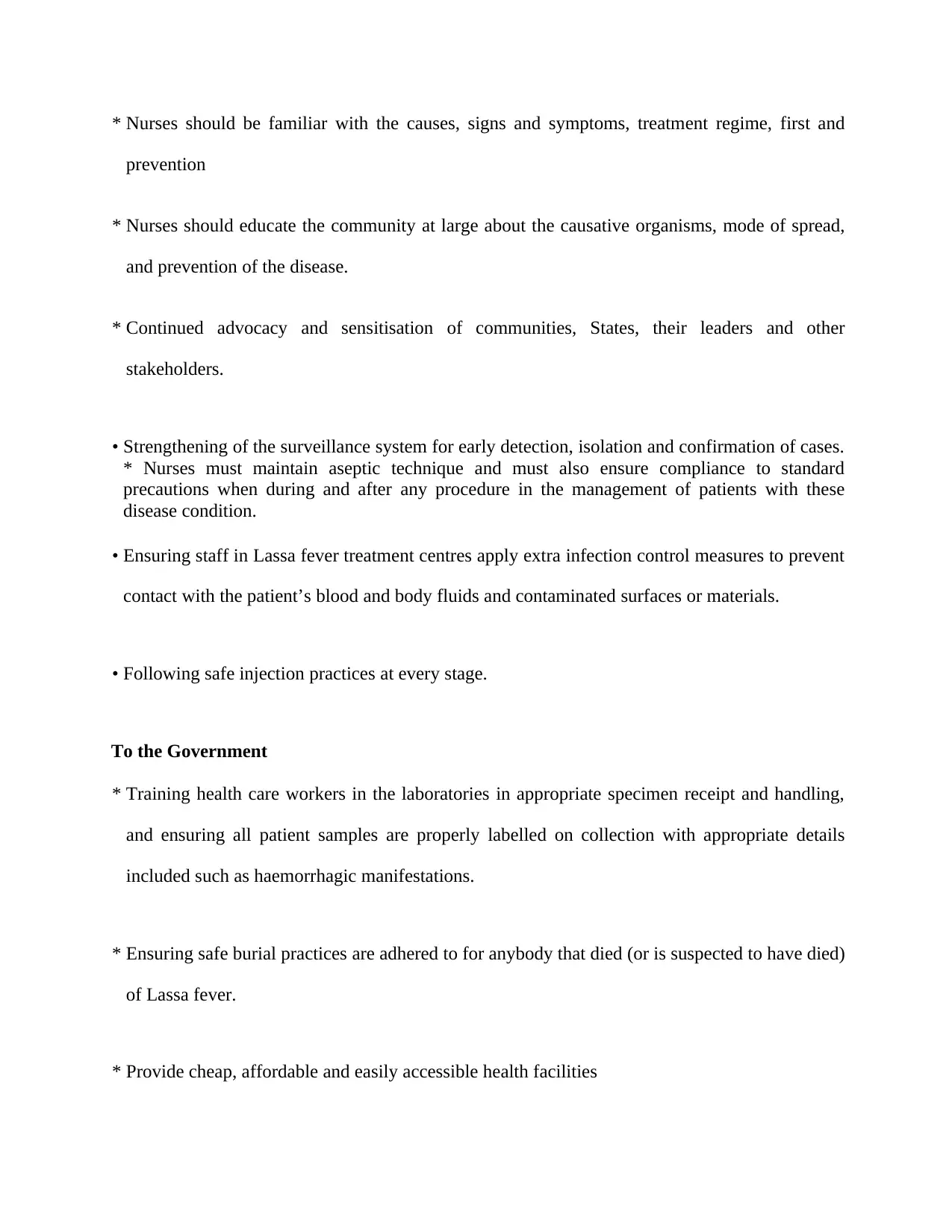
* Nurses should be familiar with the causes, signs and symptoms, treatment regime, first and
prevention
* Nurses should educate the community at large about the causative organisms, mode of spread,
and prevention of the disease.
* Continued advocacy and sensitisation of communities, States, their leaders and other
stakeholders.
• Strengthening of the surveillance system for early detection, isolation and confirmation of cases.
* Nurses must maintain aseptic technique and must also ensure compliance to standard
precautions when during and after any procedure in the management of patients with these
disease condition.
• Ensuring staff in Lassa fever treatment centres apply extra infection control measures to prevent
contact with the patient’s blood and body fluids and contaminated surfaces or materials.
• Following safe injection practices at every stage.
To the Government
* Training health care workers in the laboratories in appropriate specimen receipt and handling,
and ensuring all patient samples are properly labelled on collection with appropriate details
included such as haemorrhagic manifestations.
* Ensuring safe burial practices are adhered to for anybody that died (or is suspected to have died)
of Lassa fever.
* Provide cheap, affordable and easily accessible health facilities
prevention
* Nurses should educate the community at large about the causative organisms, mode of spread,
and prevention of the disease.
* Continued advocacy and sensitisation of communities, States, their leaders and other
stakeholders.
• Strengthening of the surveillance system for early detection, isolation and confirmation of cases.
* Nurses must maintain aseptic technique and must also ensure compliance to standard
precautions when during and after any procedure in the management of patients with these
disease condition.
• Ensuring staff in Lassa fever treatment centres apply extra infection control measures to prevent
contact with the patient’s blood and body fluids and contaminated surfaces or materials.
• Following safe injection practices at every stage.
To the Government
* Training health care workers in the laboratories in appropriate specimen receipt and handling,
and ensuring all patient samples are properly labelled on collection with appropriate details
included such as haemorrhagic manifestations.
* Ensuring safe burial practices are adhered to for anybody that died (or is suspected to have died)
of Lassa fever.
* Provide cheap, affordable and easily accessible health facilities
Paraphrase This Document
Need a fresh take? Get an instant paraphrase of this document with our AI Paraphraser
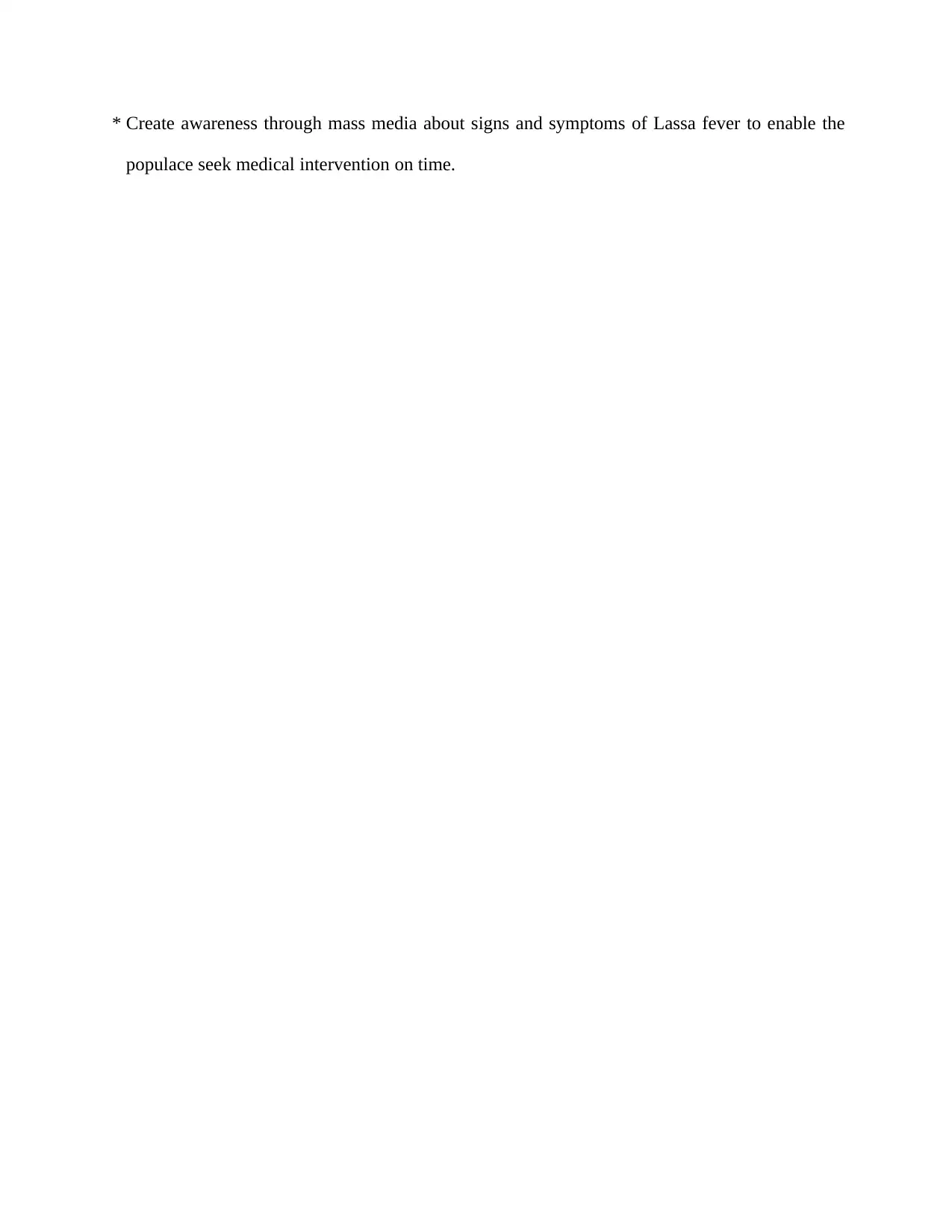
* Create awareness through mass media about signs and symptoms of Lassa fever to enable the
populace seek medical intervention on time.
populace seek medical intervention on time.

Bibliography
1. Johnson KM, McCormick JB, Webb PA, Smith ES, Elliott LH, King IJ. 1987. Clinical
virology of Lassa fever in hospitalized patients. J Infect Dis 155:456–464.
doi:10.1093/infdis/155.3.456. [PubMed] [CrossRef] [Google Scholar] [Ref list]
2. Gunther S, Weisner B, Roth A, Grewing T, Asper M, Drosten C, Emmerich P, Petersen J,
Wilczek M, Schmitz H. 2001. Lassa fever encephalopathy: Lassa virus in cerebrospinal fluid
but not in serum. J Infect Dis 184:345–349. doi:10.1086/322033. [PubMed] [CrossRef]
[Google Scholar] [Ref list].
3. Jill Seladi-Schulman, 2018 'Lassa fever' Medical news letter on June 27, 2018
4. Ajayi NA, Nwigwe CG, Azuogu BN, Onyire BN, Nwonwu EU, Ogbonnaya LU, et al.
Containing a Lassa fever epidemic in a resource-limited setting: outbreak description and lessons
learned from Abakaliki, Nigeria (January–March 2012). Int J Infect Dis 2013;17(11):e1011–6.
5. NCDC: www.ncdc.gov.ng/themes/common/docs/protocols/92_1547068532.pdf
CDC: www.cdc.gov/vhf/lassa
6. Peters CJ, Zaki S. Overview of viral hemorrhagic fevers. In: Guerrant RL, Walker DH, Weller
PF, eds. Tropical Infectious Diseases: Principles, Pathogens and Practice. Philadelphia: Churchill
Livingstone; 1999:1182-1190. [Context Link]
1. Johnson KM, McCormick JB, Webb PA, Smith ES, Elliott LH, King IJ. 1987. Clinical
virology of Lassa fever in hospitalized patients. J Infect Dis 155:456–464.
doi:10.1093/infdis/155.3.456. [PubMed] [CrossRef] [Google Scholar] [Ref list]
2. Gunther S, Weisner B, Roth A, Grewing T, Asper M, Drosten C, Emmerich P, Petersen J,
Wilczek M, Schmitz H. 2001. Lassa fever encephalopathy: Lassa virus in cerebrospinal fluid
but not in serum. J Infect Dis 184:345–349. doi:10.1086/322033. [PubMed] [CrossRef]
[Google Scholar] [Ref list].
3. Jill Seladi-Schulman, 2018 'Lassa fever' Medical news letter on June 27, 2018
4. Ajayi NA, Nwigwe CG, Azuogu BN, Onyire BN, Nwonwu EU, Ogbonnaya LU, et al.
Containing a Lassa fever epidemic in a resource-limited setting: outbreak description and lessons
learned from Abakaliki, Nigeria (January–March 2012). Int J Infect Dis 2013;17(11):e1011–6.
5. NCDC: www.ncdc.gov.ng/themes/common/docs/protocols/92_1547068532.pdf
CDC: www.cdc.gov/vhf/lassa
6. Peters CJ, Zaki S. Overview of viral hemorrhagic fevers. In: Guerrant RL, Walker DH, Weller
PF, eds. Tropical Infectious Diseases: Principles, Pathogens and Practice. Philadelphia: Churchill
Livingstone; 1999:1182-1190. [Context Link]
1 out of 39
Your All-in-One AI-Powered Toolkit for Academic Success.
+13062052269
info@desklib.com
Available 24*7 on WhatsApp / Email
![[object Object]](/_next/static/media/star-bottom.7253800d.svg)
Unlock your academic potential
© 2024 | Zucol Services PVT LTD | All rights reserved.